Sign up for our daily newsletter
- Privacy Policy
- Advertise with Us

How to Make Mobile Safari Save Your Passwords on iOS
Security experts are always reminding us that our online accounts should have strong passwords. The only problem is that remembering strong passwords for various accounts can be a real drag. Luckily, you can make Safari save your passwords on iOS so that the next time you need to sign in to your accounts, you won’t have to enter them again. In this tutorial, we show you how to do so.
How to Allow Safari to Save Your Passwords
How to add your credentials to safari manually, how to stop safari from filling in your passwords.
- How to Delete a Password From Safari's AutoFill
Frequently Asked Questions
Also read: How to Customize Your iPhone or iPad Lock Screen
You might be wondering whether it is safe to save passwords on an iOS device. Yes, it is, as Apple uses its own utility known as Apple Keychain, which stores all your usernames and passwords and encrypts them so that only you can access them. In fact, even Apple can’t access your personal data. Here’s how to make Safari save your passwords on iPhone and iPad.
- Go to the site whose credentials you want Safari to save.
- Sign in as you usually would.

- In the next window, you’ll be asked if you want to save the login information in iCloud Keychain for the next time. If you tap on “Save Password,” your credentials will be saved.

The next time you visit the site, Safari will automatically fill in the information for you to sign in.
If you have multiple logins for that same website, you will see multiple options listed. Tap the one you want to use. If there’s a third, fourth, etc., that isn’t shown, click the “Passwords” link (just above your virtual keyboard). You’ll be able to find the correct one in your list of saved logins.
Moreover, if you ever change your password on the site, you will be asked whether you want to update your password.
Also read: Safari Not Working on Your iPhone? Here’s How to Fix It
Here’s how to manually add usernames and passwords to Safari’s AutoFill.
- Open the “Settings” app on your iOS device.
- Scroll down a bit and pick “Passwords.”

- Tap on the plus sign at the top.

- Fill in the information of the site you want to save.

- Double-check for any mistakes and tap “Done.”
The passwords are used and saved not only in Safari but in other browsers and other apps as well, meaning data is saved for both web apps and mobile apps, such as Dropbox.
As a result, if you sign in to the Dropbox web app and save your login information in Safari or another browser, then open the Dropbox app later, it will use the same login information that you previously stored.
Also read: How to Unlock Your iPhone with a Face Mask On
Let’s say you want to keep your passwords, sign-in emails, and usernames on Safari – it saves all three – but don’t want the browser to fill them in automatically. Here’s how to stop Safari from filling in your passwords.
- To disable the autofill feature, go to “Settings” and select “Passwords” there.
- Look for the option to toggle off the autofill for passwords and tap on it. As long as it’s off, you can keep your passwords saved in this section, but Safari won’t autofill them.

Also read: Everything You Need to Know About Using “Shared with You” in iOS 15
How to Delete a Password From Safari’s AutoFill
Here’s how to delete a password from Safari’s AutoFill database:
- Navigate to “Settings -> Passwords.”
- Tap on “Edit” in the top-right corner.

- Select each password you want to erase by tapping the circle to its left.

- Tap on the “Delete” option at the top left.

Also read: How to Delete Hidden Apps From Your iPhone
Why are my passwords not saving on my iPhone?
If your passwords are not saving on your iPhone, you need to recheck your settings to see if you have disabled the Keychain feature in iOS Settings accidentally. In the event that it’s enabled and Safari is still not saving your passwords, try clearing the saved cache data and cookies and revisit the website.
How does Apple know if my password is compromised?
Apple detects a compromised password by matching it up with a list of passwords that have appeared in a data leak. According to Apple, this feature uses strong cryptographic techniques to regularly check derivations of your passwords against a list of breached passwords in a secure and private way that doesn’t reveal your accounts or passwords to Apple.
Can I export the passwords Safari has saved?
Yes, you can export all the passwords Safari stores in Keychain and also import them to Chrome’s password manager . However, you can only do this on a Mac and not from your iPhone. To export a CSV file of your Safari passwords:
- Open Safari and navigate to “Preferences-> Passwords.”
- Enter your password when prompted.
- Click on the three dots on the left sidebar, then on “Export All Passwords,” and save the CSV file to your computer.
Our latest tutorials delivered straight to your inbox
Ojash has been writing about tech back since Symbian-based Nokia was the closest thing to a smartphone. He spends most of his time writing, researching, or ranting about Bitcoin. Ojash also contributes to other popular sites like MakeUseOf, SlashGear, and MacBookJournal.

- The Best Tech Deals Right Now
- Is Spotify Premium Worth It?
How to Save Passwords on an iPad
Automatically fill in strong passwords on your iPad
:max_bytes(150000):strip_icc():format(webp)/matthew.s.smith.biopic-075658983c0849d5b7b0e849f94070cc.jpg)
- Beloit College
:max_bytes(150000):strip_icc():format(webp)/jonfishersquare-93eb80e77a004035887f56816d3623c5.jpg)
- Wichita Technical Institute
In This Article
Jump to a Section
- How to Use Keychain
- Enable Keychain
- Using a Third-Party Password Manager
- Frequently Asked Questions
What to Know
- In an app or web page, tap the Password field to open the iPad keyboard.
- A prompt appears with an automatically generated strong password.
- Tap Use Strong Password to select and save it or Choose My Own Password to create and save a custom one.
This tutorial shows how to save your passwords on an iPad and turn on Keychain if it's turned off. Instructions apply to iOS 15 and later.
How to Use Keychain to Save Passwords
Your iPad automatically generates passwords for web pages and in apps when it detects you've selected a password field. It also prompts you to fill in these fields with a password you previously saved in Keychain.
Follow these steps to use saved passwords on an iPad or create a new one for Keychain.
On a web page or app, tap the Password field.
A password option appears if Keychain has a password for the app. Tap it to place the password in the text field and log in as usual.
If successful, you're finished. The following steps only apply if the password doesn't appear or you need to save a new password.
If no password is saved, your iPad generates a strong password automatically.
Tap Use Strong Password to save the recommended strong password. Select Choose My Own Password to create your own instead.
Using your own password is less secure than using an automatically generated strong password. Saving passwords to your iPad means you don't need to remember each one.
If the iPad keyboard appears but no password prompt is displayed, tap the Keychain icon, which is a small, black key.
Keychain opens the Autofill Password screen with a list of saved passwords. Use the search field or scroll down to the one you need and tap it to place it in the password text field.
If you want to create another password, tap Add New Password near the top of the Autofill Password list.
Enter your username and a password . Tap Done to save the information to Keychain.
To view saved passwords, open the Settings app and select Passwords .
How to Turn On Saved Passwords on an iPad
If you don't see the prompt to save passwords or the Keychain icon, Keychain is likely turned off. Follow the steps below to turn on saved passwords on your iPad.
Open the Settings app.
Scroll down the Settings menu and tap Passwords .
Tap the toggle next to AutoFill Passwords to turn on the feature.
Can I Use a Third-Party Password Manager?
Apple Keychain is not the only way to save passwords on an iPad.
The iPadOS 15 updates added support for third-party password managers such as 1Password, LastPass, and mSecure. You can download these third-party password managers from the App Store.
After they are installed, your iPad will include the third-party password manager passwords in prompts.
An iPad can generate, save, and fill in strong passwords. This feature is available with Keychain or a third-party password manager.
If you use a third-party password manager app, you can pull up any credentials you've saved from the app itself. For Keychain passwords, go to Settings > Passwords . A list of the accounts you've saved to the Keychain will appear on the next screen; tap one to see its password.
Get the Latest Tech News Delivered Every Day
- How to Find a Wi-Fi Password on an iPhone
- How to Share Photos, Websites, and Files on the iPad
- How to Find Saved Passwords on Mac
- 3 Ways to Back Up Your iPad
- How to Tether an iPad to an iPhone
- How to Set up and Use iCloud Keychain
- How to Dictate on iPhone
- Is Google Password Manager Safe? What You Need to Consider Before Using It
- How to Save Passwords in Chrome for iOS
- How to Lock a Folder in Windows 10
- Should You Buy an iPad Keyboard? 3 Reasons Why You Might Want To
- How to Use Google Password Checkup for Android
- How to Use the Microsoft Edge Password Manager
- How to Use the Firefox Password Manager
- How to Download and Save Photos and Images to the iPad's Camera Roll
- How to Manage Android Autofill Settings
How-To Geek
How to use the password manager in safari on iphone or ipad.

Your changes have been saved
Email Is sent
Please verify your email address.
You’ve reached your account maximum for followed topics.
I Wish This Had Been My First 3D Printer, Here's Why
If you’ve never used the iphone shortcuts app, here’s the best way to get started, apple pay later is dead, thank goodness, quick links, using the passwords manager on safari for ios.
If you use Safari on your iPad or iPhone, you can store website passwords and then manage them using the Passwords settings. The passwords manager on iOS is easy to use, and one of the best we've found on mobile devices.
We know that having and using a passwords manager is all but a necessity on any computer or mobile device. For one, if you're even moderately security conscious, you are probably using strong passwords . Unfortunately, typing strong passwords on a mobile device (assuming a password with upper and lower-case letter, numbers, and symbols) is kind of a pain.
You might also change things up from website to website. It goes without saying that you shouldn't use the same password twice (easier said than done), so you need to exercise your memory in order to have a unique password for every single website.
To that end, if you use an iPhone or iPad, then Safari already includes an excellent, robust passwords manager, which we'll show and explain to you today.
Access the passwords manager by first opening the "Settings" on your iOS device. Scroll to and tap open "Safari" in the left column, then tap open the "Passwords" category.
Before you can access your passwords, you will need to verify your identity using Touch ID . On older devices that don't have Touch ID, you will need to enter your passcode.
Every account on your device will be shown. Your passwords won't appear, instead you will only see the user ID associated with each account. Notice that there's an arrow on the right edge of each account row.
Tap open any account and you will now see your user name, password, and the associated website.
Tap the "Edit" button in the upper-right corner and you can edit everything or delete the account from your device.
Back on the main passwords screen, tap the "Edit" button in the upper-right corner and notice that a selection circle appears to the left of each account row.
With the edit option enabled, you can select multiple accounts at once. The advantage to this is that you can go through all of your accounts and select the ones you no longer have or want stored, then simply tap the "Delete" button in the upper-left corner.
You don't have to actually access each account to copy your user name and password to the clipboard. From the passwords screen, you can long-press and the option for both will appear on a context menu.
We'd be remiss if we didn't point out that you can tap open the "Search" field.
When you do this, the keyboard will appear and you can then tap a few characters to find the account or user name you're seeking.
Finally, we need to point out that your passwords are saved to iCloud so they're available on all your iOS devices. If you simply want to prevent Safari information from being synced to iCloud, then tap off the button next to it in the iCloud settings.
If you want to turn off iCloud Keychain syncing, then your Safari information such as bookmarks and history will still be synced but passwords will not.
The passwords manager for Safari on iOS is clearly one of the easiest to use and you can quickly transfer information from it to other browser logins.
While we can't recommend copying sensitive information like this as plain text to your device's clipboard, it can make things substantially easier. Just be advised that doing so is a security risk.
We hope you found this article helpful and you now feel comfortable managing website user accounts and passwords on your iPhone or iPad. If you have any questions or comments, we invite you to leave your feedback in our discussion forum.
- iPhone & iPad
Personal Safety User Guide for Apple devices
- Personal safety at a glance
- What’s new in personal safety
- Use Safety Check to stop sharing
- How Safety Check works
- Additional considerations when using Safety Check
- Intro to review and take action
- Secure AirDrop and NameDrop
- Securely control whom you share content with from iPhone, iPad, and Apple Watch
- Securely control whom you share content with from Mac
- Share or stop sharing your location
- Manage automatic ETA sharing in Maps
- Manage Location Services settings
- Stop and remove location metadata in Photos
- Stay safe with AirTag
- Safely manage how you forward content
- Reject unknown sign-in attempts
- Record suspicious activity
- Store your data securely in iCloud
- Delete suspicious content
- Manage Family Sharing settings
- Avoid fraudulent requests to share info
- Securely control your Home accessories
- How to erase all content and settings
- Restore the data you backed up
- Intro to privacy and safety tools
- Update your Apple software
- Set a unique passcode or password
- Secure your iPhone or iPad with Face ID
- Secure your devices with Touch ID
- Delete unknown fingerprints from iPhone or iPad
- Add or delete fingerprints on your Mac
- Keep your Apple ID secure
- Use two-factor authentication
- Help prevent being locked out of your device
Keep your device, app, and website passwords secure on iPhone and iPad
- Manage shared password and passkeys
- App privacy features in Apple products
- Harden your devices against mercenary spyware
- Manage safety settings in Messages
- Use Check In for Messages
- Block calls and messages
- Receive warnings about sensitive images and videos on iPhone, iPad, and Mac
- Keep your browsing history private
- Make an emergency call or text on iPhone or Apple Watch
- Obtain evidence related to another person’s account
- See who has access to your iPhone or iPad
- How to stop sharing your iPhone or iPad content
- How to stop sharing your iPhone or iPad location
On your iPhone or iPad, you can manage your passwords in Settings, in Spotlight Search, or using Siri. You can also use the Password Security Recommendations feature to identify any weak or vulnerable passwords. Saved passwords appear in alphabetical order organized by the website or platform they’re saved on.
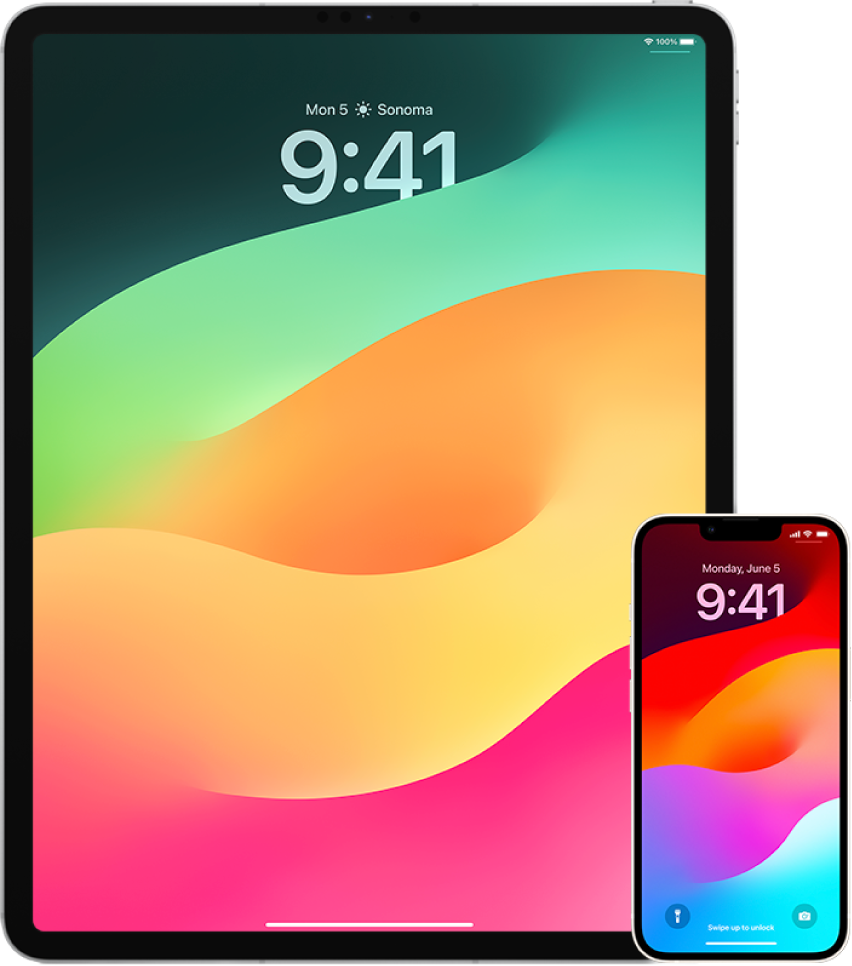
Manage passwords
You can manage your passwords in Settings, in Spotlight Search, or using Siri.
To add a new password manually, tap Add in the top-right corner.
To edit or delete a password, tap Edit in the top-right corner, tap “Select saved passwords,” then tap Edit or Delete.
Important: After you’ve deleted a password, you can no longer recover it.
If you added a new password, test it to make sure you entered it correctly.
Use Password Security Recommendations
If you create and store your own passwords for websites and apps, you can use the Password Security Recommendations feature to identify any weak or vulnerable passwords (for example, if they’re easily guessed or used multiple times). You can also use the feature to securely monitor your passwords and to alert you if any have been compromised through a known data leak.
Turn on the Detect Compromised Passwords to let iPhone securely monitor your passwords and to alert you if any passwords have appeared in known data leaks.
Review these recommendations for the passwords you’ve created:
Passwords marked as reused have been used across different domains. Using the same password for more than one service may leave the account vulnerable to an attacker who has discovered your credentials.
Passwords marked as weak may be easily guessed by an attacker.
Passwords are marked as leaked if the Password Monitoring feature has identified them in a known data leak.
To make an update to a reused, weak, or leaked password, tap the item and follow the onscreen instructions.
Turn on detection of compromised passwords
iPhone and iPad (running iOS 17 , iPadOS 17 , or later) can monitor your passwords and alert you if they appear in known data leaks.
Automatically delete one-time verification codes
In iOS 17 , iPadOS 17 , and macOS Sonoma 14 , or later, one-time verification codes are filled in automatically, so you don’t need to leave the app or website you’re signing into. You can choose to automatically delete the verification codes after entering them with Autofill, or keep them.
Do one of the following:
Download this guide as a PDF
Safari Password Manager: How to save, view and manage passwords in Apple's browser
Thanks to iCloud Keychain, you can save browser username and password combinations.
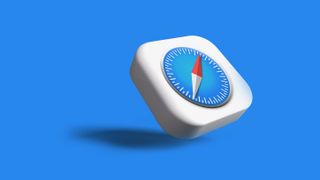
- Quick steps
Tools and Requirements
Step by step guide to using the safari password manager, final thoughts.
You probably already know about iCloud if you're using at least one Apple device. The cloud storage and synchronization service allows it to store and access content across multiple devices, including Mac, iPhone, iPad, and more. These include files and information like documents, photos, music, video, and contacts.
Apple's iCloud service is also at the heart of the iCloud Keychain , where you can store website usernames/passwords, among other items. In this how-to, we're concentrating on how to add, edit, and delete Safari password content. Similar tools are available on other browsers like Microsoft Edge and Mozilla Firefox .
- You should also consider the best browsers and best secure browsers .
Steps for saving, viewing and managing passwords
- Before you can save any username/password combinations, you must first be sure to have an Apple ID or iCloud account.
- From there, you can begin adding usernames and passwords for websites you frequent.
- You can also take advantage of Apple's new passkey feature.
- Safari is only available on Apple devices such as Mac, iPhone, and iPad.
1. Go into the manager
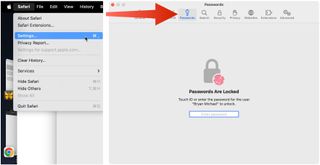
To get started, you must first create an Apple ID . The username/password combinate is usable across all Apple devices to log into iCloud.com. You can proceed once you have an Apple ID and are logged into your device.
On Mac, the Safari password manager is located by choosing Safari on the menu bar at the top left of your Mac. From there, click Settings from the pull-down menu.
Next, click on the Passwords option at the top. Input your password as needed.
2. Adjust existing password settings

You can adjust password information in the iCloud Keychain directly from Safari. To get started, go into the Passwords section of Mac Settings (see above) and log in as necessary. Then, use the search box on the left side of the display to find the password information you wish to change. Click Edit .
You can change the username and password for a website and add notes when applicable. After making a change, click Save .
Click Delete Password to delete the password information.
Thanks to iCloud, any changes you make here will also be reflected in other Apple devices that use your Apple ID.
4. Using Autofill in Safari
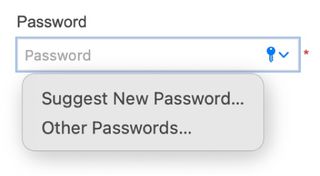
With AutoFill, you can fill in your previously saved usernames and website passwords. The tool is also a great way to add a new username/password combination for the first time and to create a strong password.
You will see AutoFill pop up when a website asks you to create a password.
You will see an Autofill prompt In Safari when it's time to use or create a password.
Click the AutoFill Key button, then choose Suggest New Password . For optimal security, you should use the suggested strong password. However, if you choose not to use the suggested password, you can easily select the password field, click “ Don’t Use ,” and enter your preferred password.
From there, enter the rest of the required information to create the website account.
Why use a separate password manager instead of a browser?
While most web browsers have their own password management feature, except for Safari which incorporates it into iCloud Keychain, in-browser password managers have limitations. They can only be used with one specific browser and cannot be accessed from other browsers. On the other hand, standalone password managers are compatible with any browser on your device, making them a more versatile option. Moreover, it is important to consider security when choosing a password manager. Browsers are not updated as frequently as standalone password managers, which can pose a security risk in case of a breach.
Does Safari have a built-in VPN?
Like many other browsers, Safari does not come with a pre-installed VPN. However, several reliable third-party VPNs like ExpressVPN, NordVPN, and SurfShark can easily be integrated with Safari. With a VPN, you can significantly boost the security and privacy of your online activities.
Are browser password managers safe?
To guarantee the safety of your passwords, using browser password managers like Safari with encryption is a great first step. However, there are additional measures you can take to further enhance your protection. It is highly recommended to create a strong and secure master password. The newest optional feature in Microsoft Edge mandates that you input your master password before making any changes to the password manager, thereby adding an extra layer of security. Regularly backing up your password manager is also a wise precaution in case of loss or theft. Another crucial step is creating a Firefox profile, allowing content synchronization across devices. This ensures that any changes made on your computer are reflected on your mobile device and vice versa.
What is iCloud Keychain?
iCloud Keychain is a highly reliable password manager that securely stores sensitive information such as passwords and credit card details in an online vault as part of Apple’s iCloud suite of services. Users can easily access their stored data by simply logging in to the same iCloud account on any Apple device. Thanks to the end-to-end encryption feature, user data is protected and can only be accessed by the user, even in the unlikely event of an iCloud account breach. Furthermore, the two-factor authentication feature provides an extra layer of security to user accounts, ensuring that they remain safe and secure at all times.
What are Apple Passkeys?
Apple Passkeys hope to eliminate the need for passwords eventually. This authentication method adheres to industry standards and guarantees improved security features while streamlining the login experience.
Passkeys create a unique cryptographic key pair for every website or application you use. The website or app stores the public key while the private one remains on your device. When you log in, your device produces a cryptographic signature using the private key. The website or application can then authenticate your identity by verifying this signature. With Passkeys, you can rest assured that your online security is in good hands.
Like passwords, passkeys are kept in Apple's iCloud Keychain.
The built-in Safari password manager, part of the iCloud Keychain, makes tracking website usernames and passwords easier. Better still, those items carry over to other Apple devices, including iPhone and iPad. In the coming years, Apple hopes to eliminate the need for passwords and replace them with more secure passkeys. However, username and password combinations remain the most popular choice for website authentication.
You might also be interested in Google Chrome now supports passkey for everyone and the best free password managers .
Are you a pro? Subscribe to our newsletter
Sign up to the TechRadar Pro newsletter to get all the top news, opinion, features and guidance your business needs to succeed!
Bryan M. Wolfe is a staff writer at TechRadar, iMore, and wherever Future can use him. Though his passion is Apple-based products, he doesn't have a problem using Windows and Android. Bryan's a single father of a 15-year-old daughter and a puppy, Isabelle. Thanks for reading!
Asus patches serious security flaw across multiple routers — update now if you have any of these models
Keytronic confirms data breach after Black Basta ransomware gang strikes again
Logitech's new MX Ink stylus might be a dream art tool for your Meta Quest headset
Most Popular
- 2 IKEA solves your charging headaches with its new cheap, colorful USB-C accessories
- 3 7 new movies and TV shows to watch on Netflix, Prime Video, Max, and more this weekend (June 14)
- 4 Truist Bank confirms data breach after stolen data appears online
- 5 I tested a premium and budget mini-LED 4K TV side-by-side – here are the real-world differences
- 2 ChatGPT has caused a massive drop in demand for online digital freelancers — here is what you can do to protect yourself
- 3 Mini PC newcomer takes market by storm with socketable CPU — and, surprise, surprise, a mysterious direct PCIe connection, that's faster than Thunderbolt 4 and no, it's not OCuLink
- 4 Instagram is tagging real photos as 'Made with AI' – and photographers aren't happy
- 5 A walking expert says walking 10,000 steps a day is 'irrelevant' if you’re not doing this one thing
How To Save Password On Safari IPad

- Software & Applications
- Browsers & Extensions
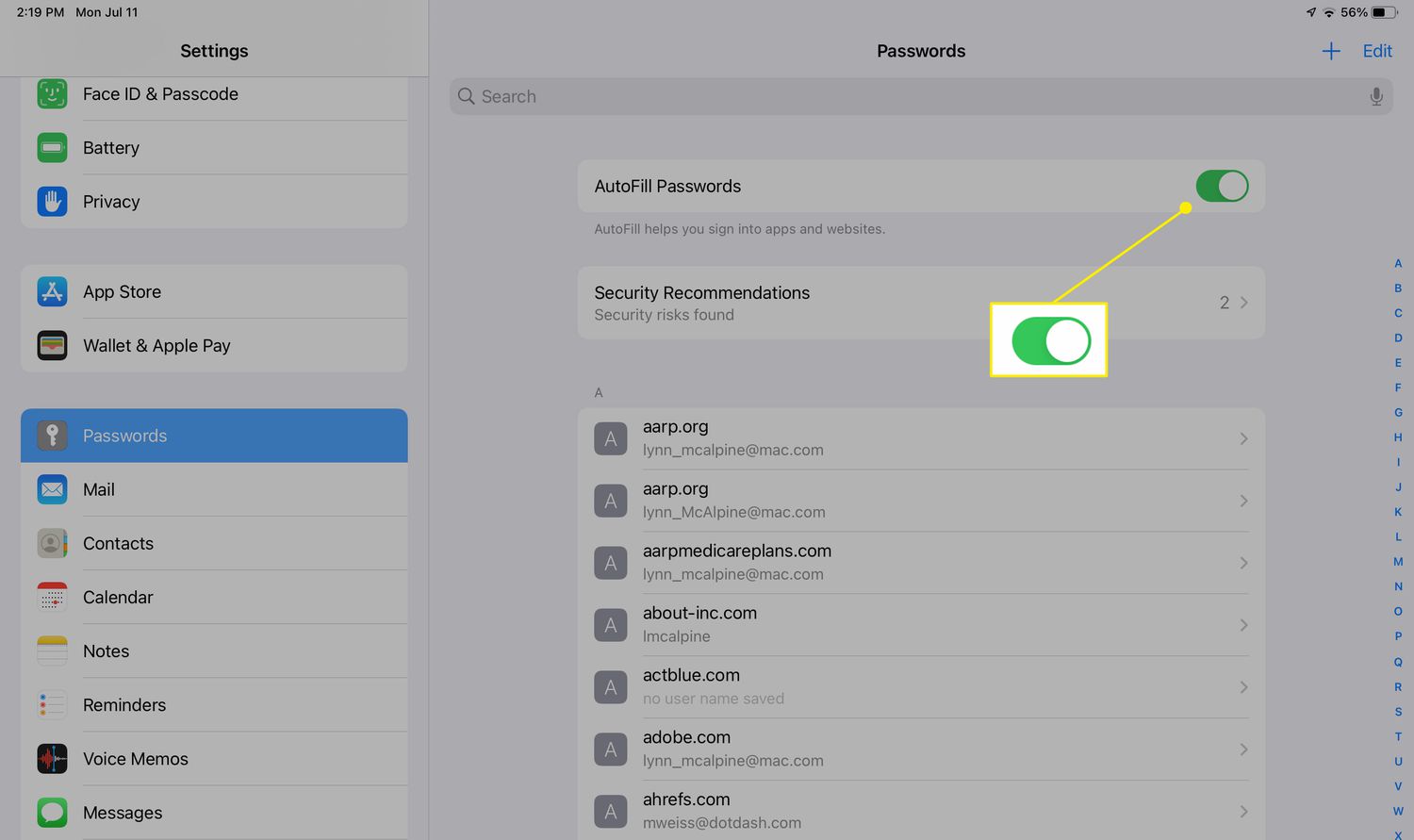
Introduction
Safari, the default web browser on iPad, offers a convenient feature called Password AutoFill, which allows users to securely store and access their login credentials for various websites. This functionality not only streamlines the login process but also enhances the overall browsing experience by eliminating the need to repeatedly enter usernames and passwords. By leveraging this feature, iPad users can enjoy a seamless and secure online experience, without the hassle of remembering and manually inputting their login details each time they visit a website.
In this article, we will delve into the intricacies of setting up Password AutoFill on Safari for iPad, saving passwords for different websites, and managing the stored login credentials. By following these simple yet effective steps, users can harness the full potential of Safari's Password AutoFill feature, thereby optimizing their browsing activities and bolstering their digital security.
Let's embark on this insightful journey to unlock the power of Safari's Password AutoFill on iPad, empowering users to navigate the digital landscape with ease and confidence.
Setting Up Password AutoFill on Safari
Enabling Password AutoFill on Safari for iPad is a straightforward process that empowers users to effortlessly manage their login credentials. To begin, users can access the Settings app on their iPad and scroll down to find the "Safari" option. Tapping on "Safari" will reveal a plethora of customization settings, including the "Passwords" section, which is pivotal for configuring the Password AutoFill feature.
Upon entering the "Passwords" section, users can toggle the "AutoFill Passwords" option to activate this functionality. Additionally, users can choose to enable the "Names and Passwords" option, which allows Safari to automatically fill in both usernames and passwords on websites, further streamlining the login process.
Furthermore, users have the option to integrate iCloud Keychain with Safari's Password AutoFill feature. By enabling iCloud Keychain, users can seamlessly sync their saved passwords across their Apple devices, ensuring consistent access to their login credentials regardless of the device they are using.
Once these settings are configured, Safari is primed to leverage the power of Password AutoFill, providing users with a hassle-free method to manage and utilize their website login information. With these simple yet impactful adjustments, users can harness the full potential of Safari's Password AutoFill feature, enhancing their browsing experience and bolstering their digital security.
By following these intuitive steps, users can unlock the convenience and security benefits of Password AutoFill on Safari for iPad, paving the way for a seamless and protected online journey.
Saving Passwords for Websites
When it comes to seamlessly managing login credentials for various websites, Safari's Password AutoFill feature offers a user-friendly and secure solution. After configuring the Password AutoFill settings in Safari , users can effortlessly save their login details for different websites, ensuring quick and convenient access during subsequent visits.
Upon visiting a website and entering login credentials, Safari prompts users to save the password for that specific site. This prompt typically appears as a pop-up notification, offering users the option to save the entered username and password. By selecting the "Save Password" prompt, users can securely store their login information within Safari's Password AutoFill system.
Once the password is saved, Safari conveniently auto-fills the login credentials whenever users revisit the website, eliminating the need to manually enter the username and password each time. This streamlined process not only saves time but also enhances the overall browsing experience, allowing users to seamlessly access their favorite websites without the hassle of repeatedly inputting their login details.
Moreover, Safari's Password AutoFill feature ensures the security of saved passwords by requiring user authentication, such as Face ID, Touch ID, or device passcode, before revealing the stored login credentials. This robust security measure adds an extra layer of protection, safeguarding users' sensitive information from unauthorized access.
By leveraging Safari's Password AutoFill functionality, users can effectively manage their website login details, streamlining the login process and enhancing their digital security. This seamless integration of password saving and auto-filling empowers users to navigate the web with ease and confidence, without the burden of remembering and manually inputting their login credentials for each website they visit.
In essence, the process of saving passwords for websites on Safari epitomizes convenience and security, offering users a hassle-free approach to managing their login information and optimizing their browsing activities. With this intuitive feature at their disposal, users can embrace a more streamlined and secure online experience, ensuring swift access to their favorite websites while prioritizing the protection of their sensitive data.
Managing Saved Passwords
Once users have accumulated a collection of saved passwords within Safari's Password AutoFill system, it becomes essential to understand how to effectively manage and access these stored login credentials. Safari offers a seamless and intuitive approach to managing saved passwords, empowering users to maintain control over their login information while ensuring the utmost security.
To access and manage saved passwords in Safari, users can navigate to the Settings app on their iPad and locate the "Safari" option. Within the Safari settings, selecting the "Passwords" section provides users with a comprehensive overview of their saved login credentials. Upon entering this section, users may be prompted to authenticate their identity using Face ID, Touch ID, or their device passcode, reinforcing the security measures surrounding the stored passwords.
Within the "Passwords" section, users can view a list of websites for which passwords have been saved. This organized display allows users to easily locate specific websites and their associated login credentials. Moreover, Safari enables users to edit or delete saved passwords as needed, providing flexibility and control over the stored information.
In addition to managing saved passwords directly within the Safari settings, users can also leverage the iCloud Keychain feature to sync and access their saved passwords across their Apple devices. This seamless synchronization ensures that users can conveniently retrieve their login credentials on various devices, enhancing the accessibility and usability of the saved passwords.
Furthermore, Safari's robust security measures play a pivotal role in managing saved passwords, as the system requires user authentication before revealing or editing the stored login credentials. This stringent security protocol adds an extra layer of protection, safeguarding users' sensitive information from unauthorized access and ensuring peace of mind when managing saved passwords within Safari.
By effectively managing saved passwords in Safari, users can maintain a streamlined and secure approach to accessing their login credentials for various websites. This seamless management process, coupled with Safari's stringent security measures, empowers users to navigate the digital landscape with confidence, knowing that their saved passwords are protected and easily accessible when needed.
In essence, the ability to manage saved passwords within Safari exemplifies the platform's commitment to user convenience and security, offering a comprehensive solution for organizing and accessing login credentials while prioritizing the protection of sensitive information. With these intuitive management capabilities at their disposal, users can embrace a seamless and secure browsing experience, knowing that their saved passwords are efficiently controlled and safeguarded within Safari's Password AutoFill system.
In conclusion, Safari's Password AutoFill feature for iPad presents a compelling blend of convenience and security, offering users a seamless solution for managing and accessing their website login credentials. By configuring the Password AutoFill settings within Safari, users can streamline the login process and eliminate the need to repeatedly enter usernames and passwords for their favorite websites. The integration of iCloud Keychain further enhances this convenience by synchronizing saved passwords across Apple devices, ensuring consistent access to login credentials.
The process of saving passwords for websites on Safari epitomizes efficiency and user-friendliness, as users can effortlessly store their login details and benefit from the auto-filling functionality during subsequent visits. This streamlined approach not only saves time but also enhances the overall browsing experience, allowing users to navigate the web with ease and confidence.
Furthermore, the robust security measures embedded within Safari's Password AutoFill system, including user authentication requirements and stringent privacy protocols, underscore the platform's commitment to safeguarding users' sensitive information. This emphasis on security ensures that saved passwords are protected from unauthorized access, instilling trust and peace of mind among users.
The ability to effectively manage saved passwords within Safari empowers users to maintain control over their login credentials while benefiting from seamless synchronization across their Apple devices. This comprehensive management process, coupled with Safari's stringent security measures, reinforces the platform's dedication to user convenience and data protection.
In essence, Safari's Password AutoFill feature for iPad represents a pivotal component of the browsing experience, offering a harmonious balance between convenience and security. By embracing this feature, users can optimize their online activities, confidently accessing their favorite websites while prioritizing the protection of their sensitive data.
As users continue to navigate the digital landscape, Safari's Password AutoFill feature stands as a steadfast ally, simplifying the login process and fortifying the security of saved passwords. With its intuitive functionality and unwavering commitment to user privacy, Safari's Password AutoFill on iPad remains a cornerstone of the platform's dedication to enhancing the browsing experience while prioritizing the protection of users' sensitive information.
Leave a Reply Cancel reply
Your email address will not be published. Required fields are marked *
Save my name, email, and website in this browser for the next time I comment.
- Crowdfunding
- Cryptocurrency
- Digital Banking
- Digital Payments
- Investments
- Console Gaming
- Mobile Gaming
- VR/AR Gaming
- Gadget Usage
- Gaming Tips
- Online Safety
- Software Tutorials
- Tech Setup & Troubleshooting
- Buyer’s Guides
- Comparative Analysis
- Gadget Reviews
- Service Reviews
- Software Reviews
- Mobile Devices
- PCs & Laptops
- Smart Home Gadgets
- Content Creation Tools
- Digital Photography
- Video & Music Streaming
- Online Security
- Online Services
- Web Hosting
- WiFi & Ethernet
- Browsers & Extensions
- Communication Platforms
- Operating Systems
- Productivity Tools
- AI & Machine Learning
- Cybersecurity
- Emerging Tech
- IoT & Smart Devices
- Virtual & Augmented Reality
- Latest News
- AI Developments
- Fintech Updates
- Gaming News
- New Product Launches
5 Ways to Improve IT Automation
- What is Building Information Modelling
Related Post
Sla network: benefits, advantages, satisfaction of both parties to the contract, what is minecraft coded in, how much hp does a diablo tuner add, what is halo-fi, what is halo lock iphone, related posts.
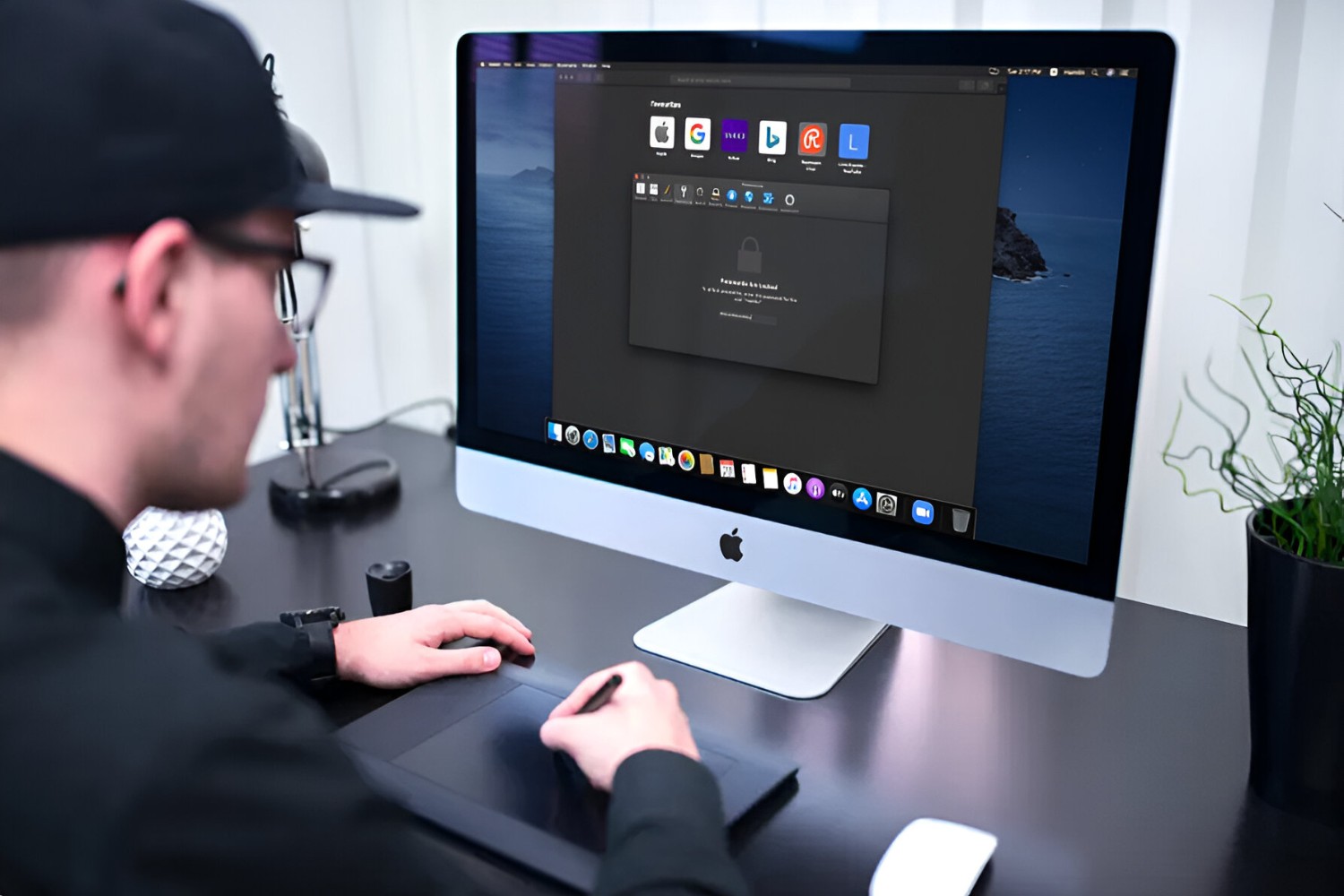
How To See Your Passwords In Safari
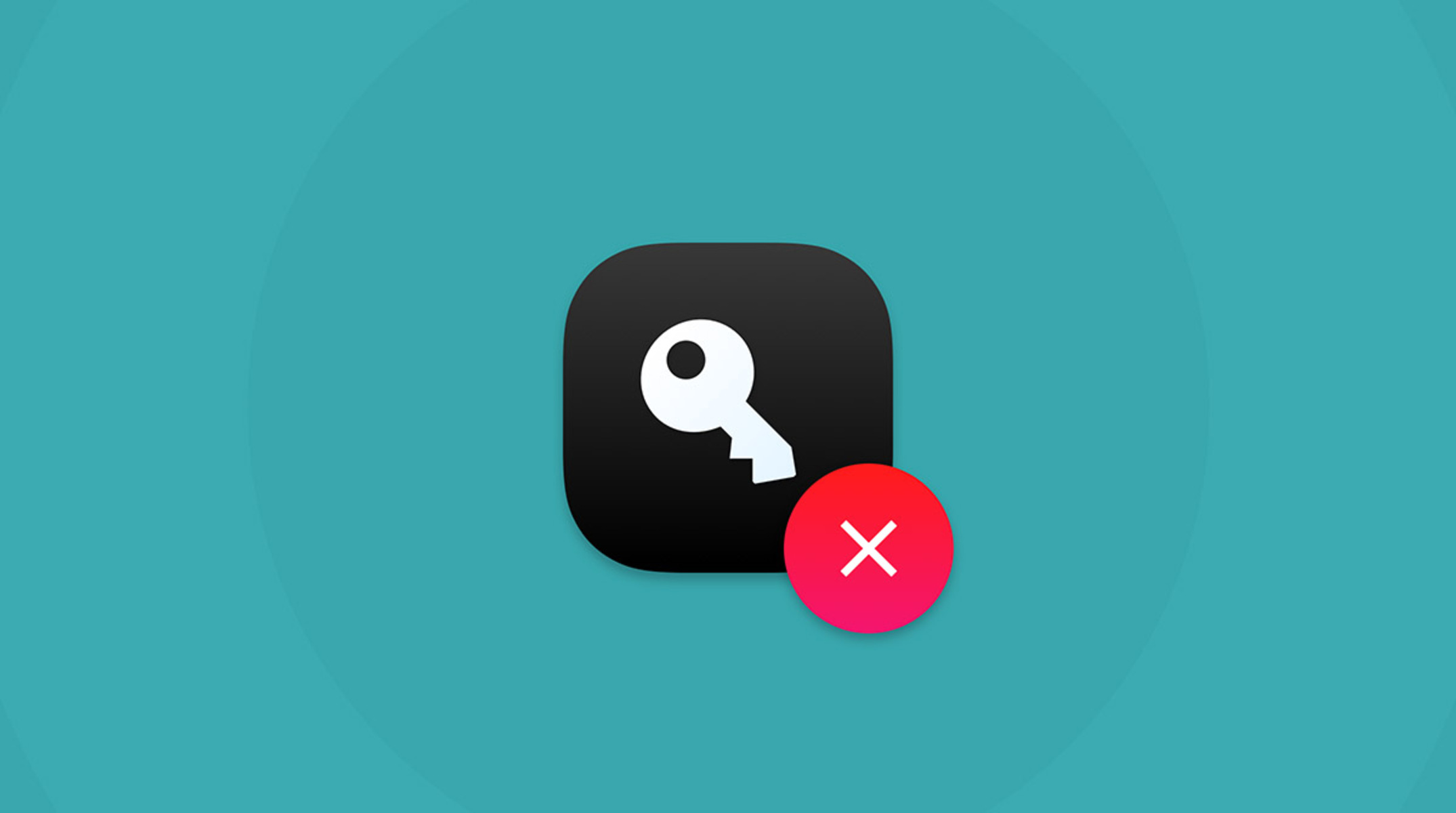
How To Delete Passwords On Safari
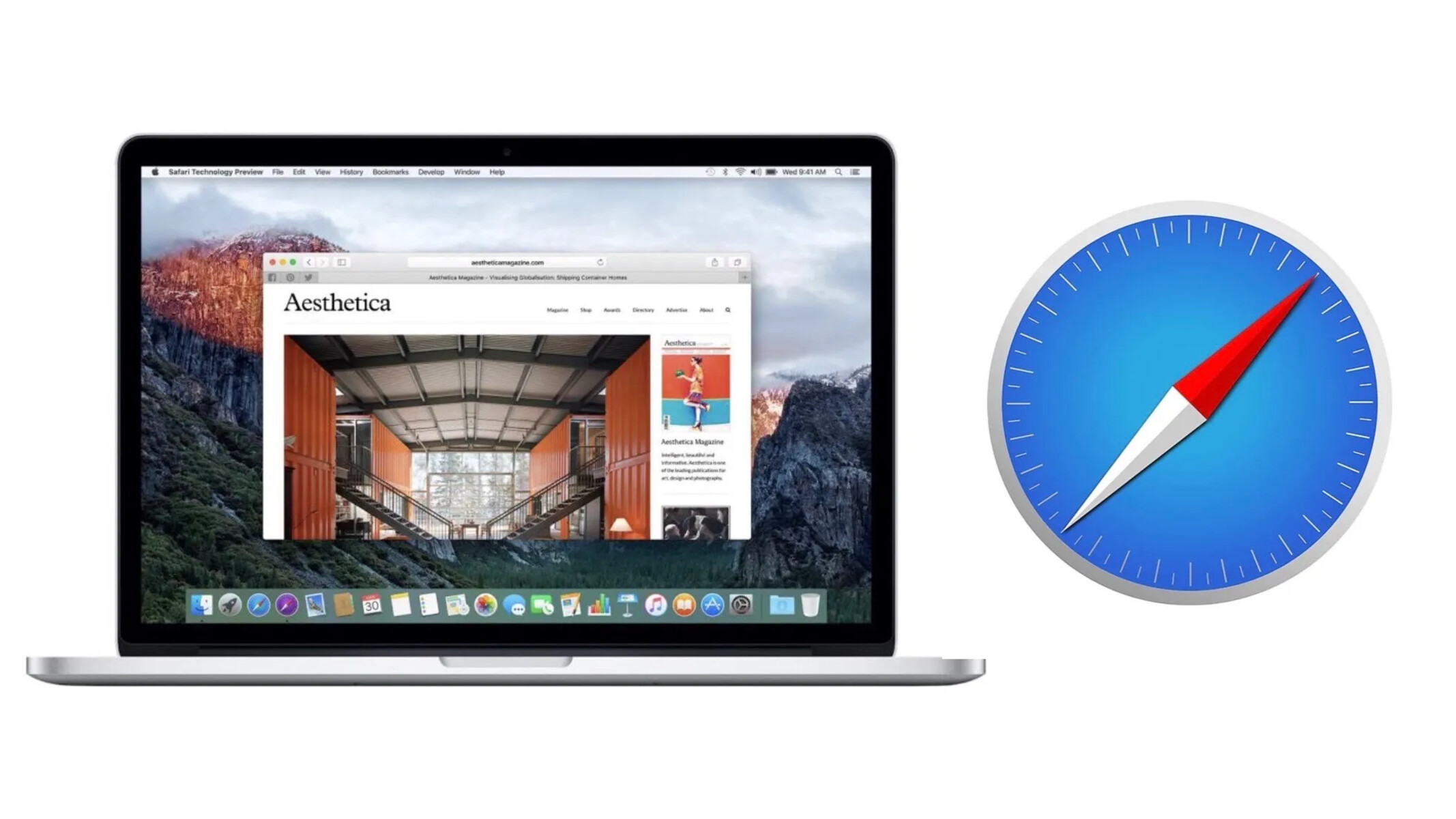
How To See The Passwords Saved In Safari
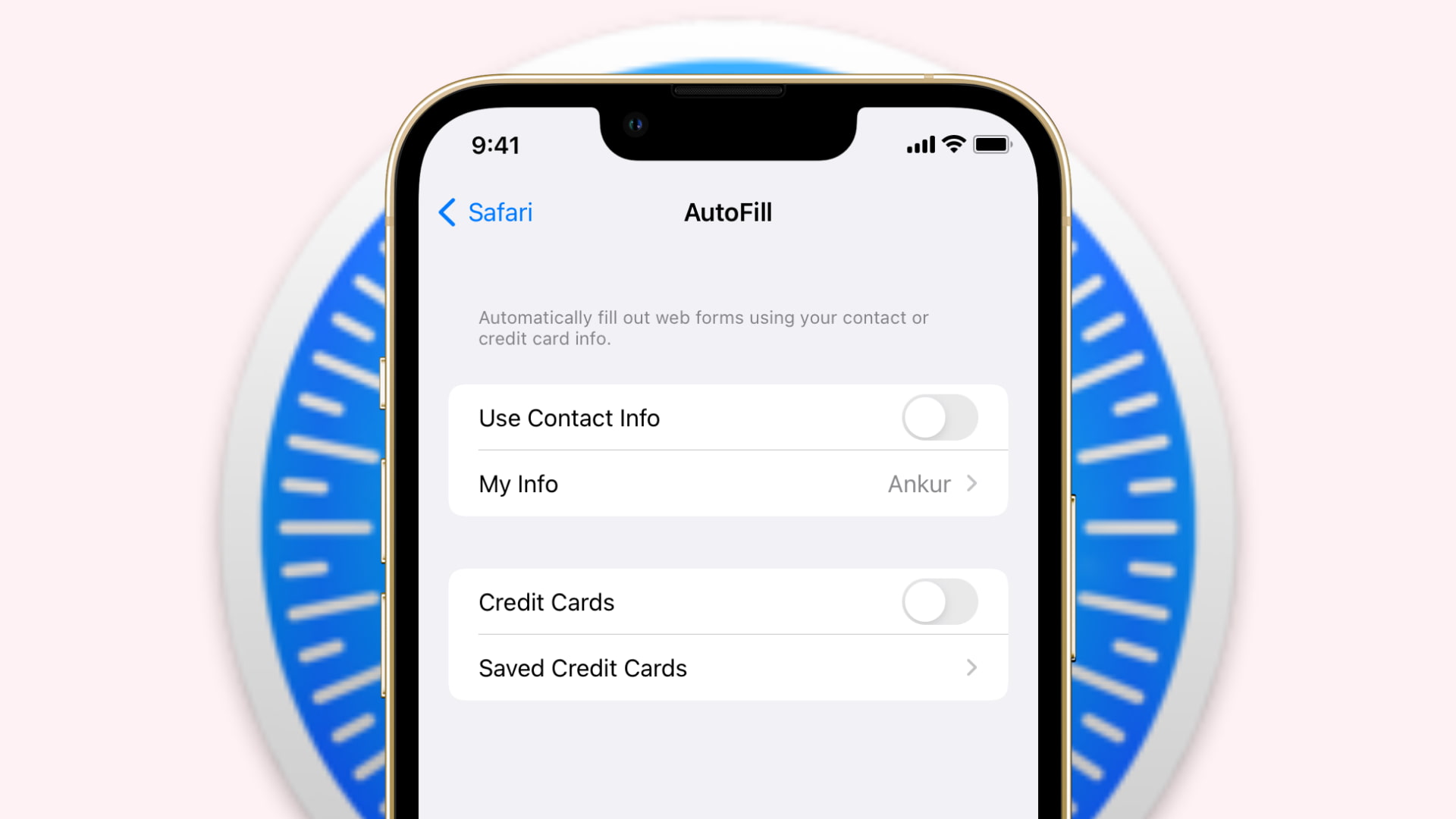
How To Stop Autofill In Safari
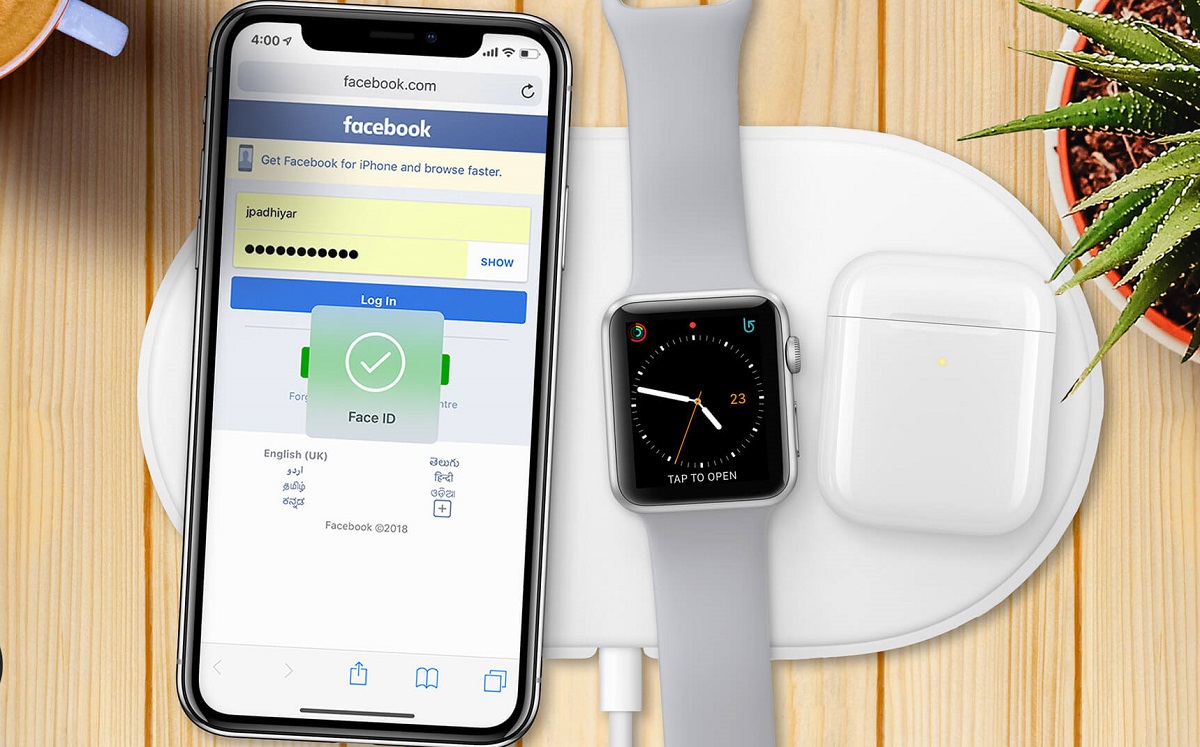
How To Use Face ID For Passwords On Safari
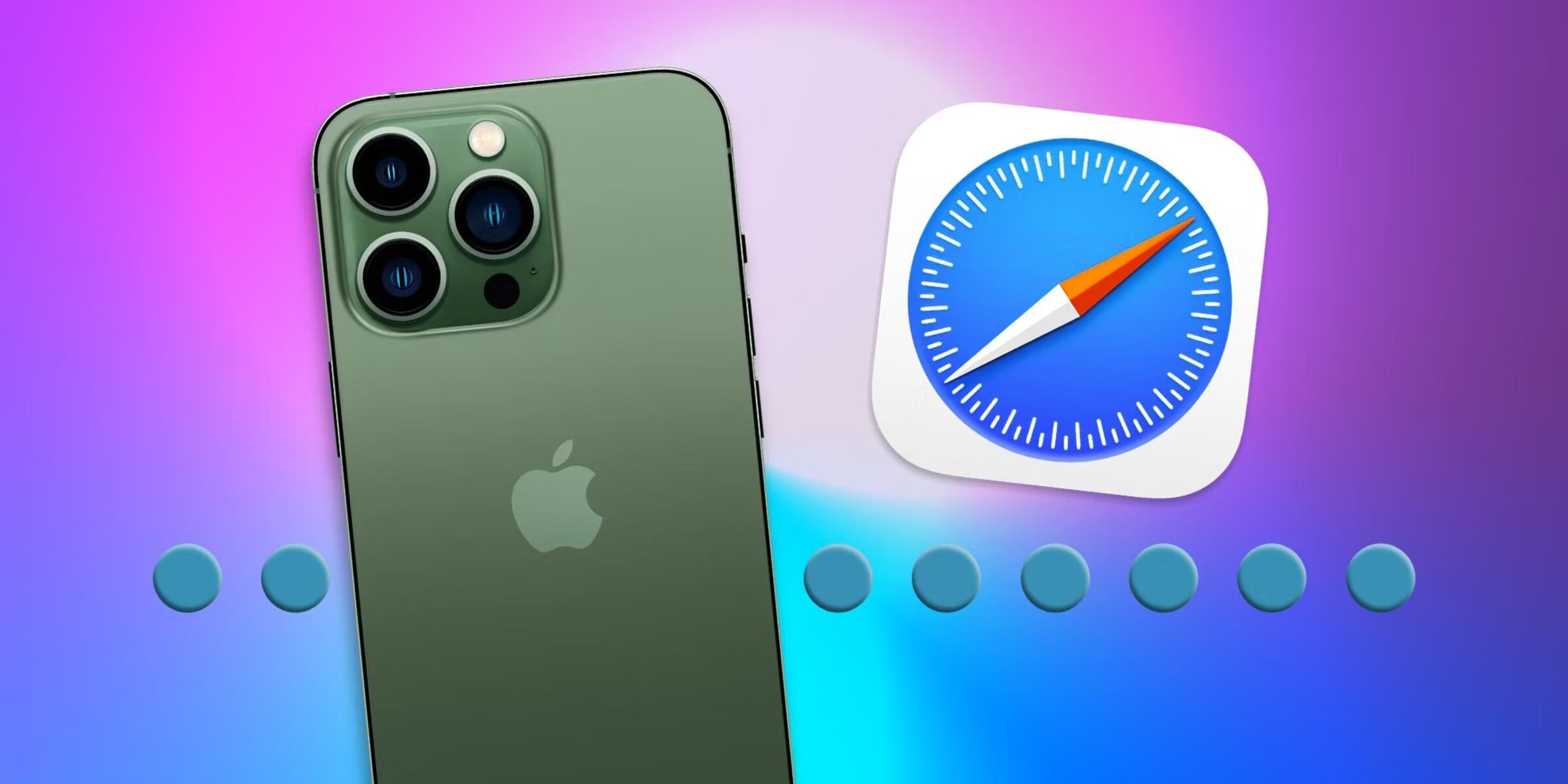
How To Save Passwords In Safari
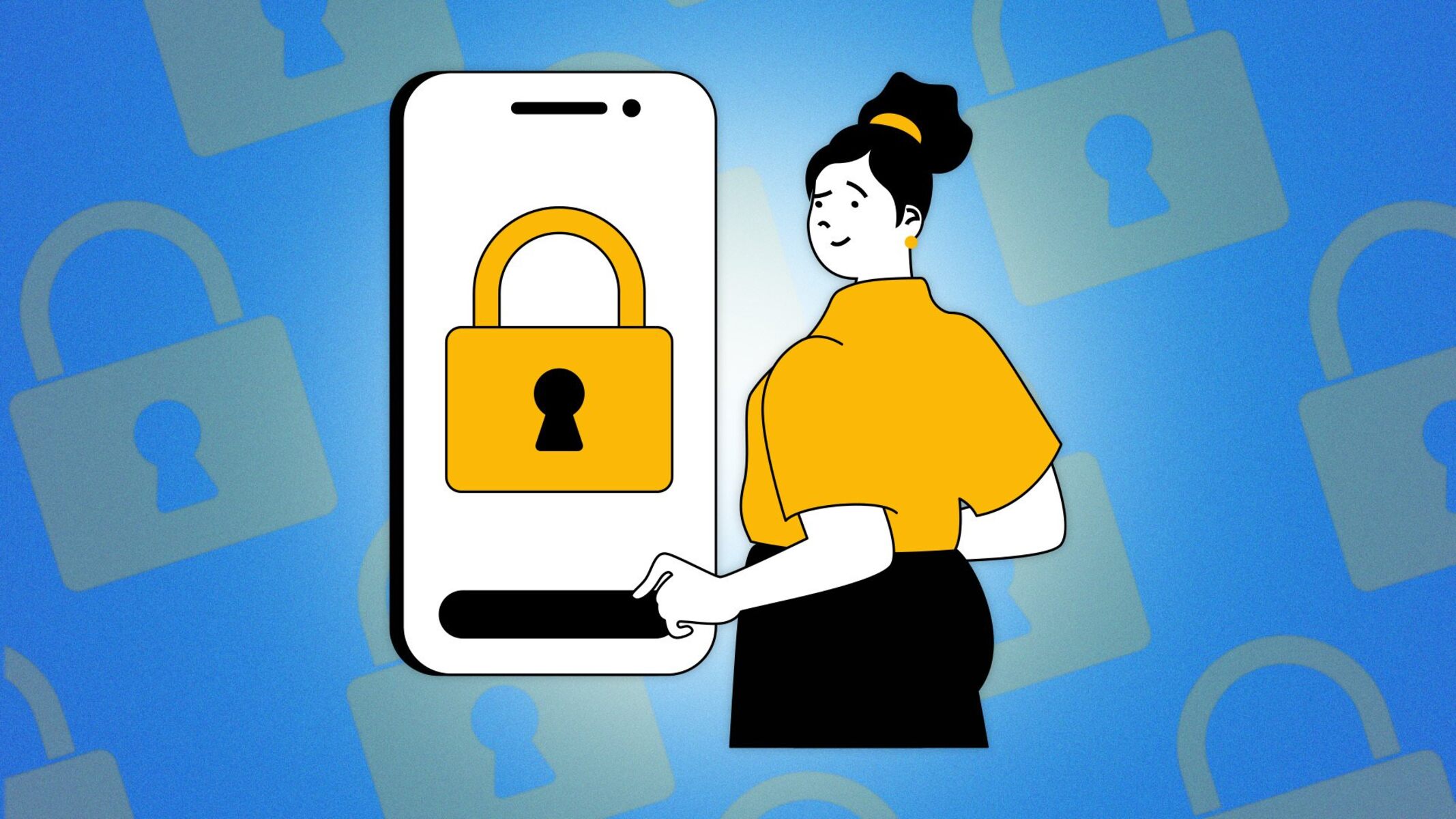
How To Unsave Passwords On Safari
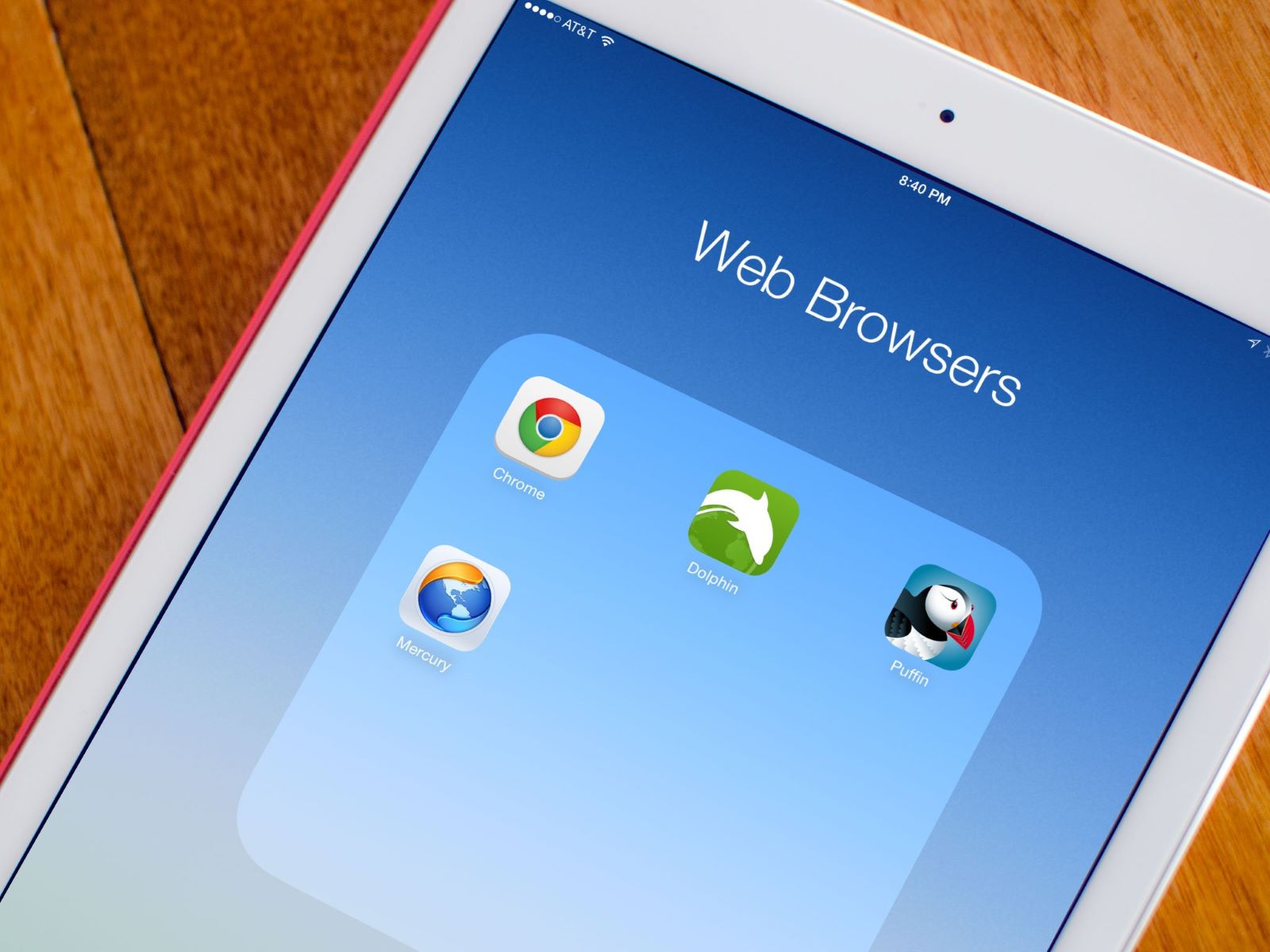
How To Update My Browser On My iPad
Recent stories.

What is Building Information Modelling?

How to Use Email Blasts Marketing To Take Control of Your Market

Learn To Convert Scanned Documents Into Editable Text With OCR

Top Mini Split Air Conditioner For Summer

Comfortable and Luxurious Family Life | Zero Gravity Massage Chair

Fintechs and Traditional Banks: Navigating the Future of Financial Services

AI Writing: How It’s Changing the Way We Create Content

- Privacy Overview
- Strictly Necessary Cookies
This website uses cookies so that we can provide you with the best user experience possible. Cookie information is stored in your browser and performs functions such as recognising you when you return to our website and helping our team to understand which sections of the website you find most interesting and useful.
Strictly Necessary Cookie should be enabled at all times so that we can save your preferences for cookie settings.
If you disable this cookie, we will not be able to save your preferences. This means that every time you visit this website you will need to enable or disable cookies again.
How to find saved passwords and credit cards on your iPhone in iOS 17
How to find your passwords and credit cards on iOS 17!

While iOS's iCloud Keychain and Passwords features are fantastic when it comes to auto-filling information on your iPhone, iPad, or Mac, both also serve as a very handy repository for a lot of your information.
For instance, if you're trying to buy something and you don't have the option to use autofill on iOS, you can dive into your settings to find your stored passwords, credit card information, and more. This is handy for making payments over the phone, or double-checking the password of an account before you try to log in somewhere new. Given how sensitive all this information is, it's stored safely behind iPhone's Touch ID or Face ID security measures, meaning you're the only person who can access it.
So how do you find your passwords and credit card information on your iPhone? Luckily, iOS 17 features a dedicated section for your passwords, while autofill information for credit cards can easily be found in your Safari settings, here's everything you need to know.
How to find passwords on iPhone
The iOS Settings app includes a standalone Passwords section which lists all of your saved accounts, usernames, and passwords in one place. Not only does it show you what these passwords are, but it can even make security recommendations based on whether Apple has detected compromised passwords in data breaches or leaks. Here's how to find passwords on iPhone:
- Open the Settings app
- Scroll down and tap Passwords
- Verify your identity with Face ID or Touch ID
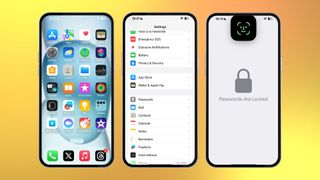
- Scroll down and tap the website name that you want the password for
- Tap the Password tab to reveal the password
- If you need to paste it somewhere, tap Copy

How to set up AutoFill on iPhone
If you aren't using it already, you can enable AutoFill within Safari, which makes it easier to enter information such as your name, address, and more.
- Scroll down and tap Safari
- Under the General section tap AutoFill

- Tap My Info
- Select your name from your contacts list

How to find credit card information on iPhone
Just like your passwords, you can find your stored credit card information on your iPhone. This can be handy if you're making a payment over the phone, or entering your details for the first time without AutoFill assistance. Here's how to find it:
- Tap Saved Credit Cards
- Use Face ID or Touch ID to verify your identity (or your four-digit code)
- Select the credit card you want to view

Your iPhone will then show you your card's name, number, expiry, security code, and a brief description. All of this information can be edited by pressing edit in the top right-hand corner.
Master your iPhone in minutes
iMore offers spot-on advice and guidance from our team of experts, with decades of Apple device experience to lean on. Learn more with iMore!
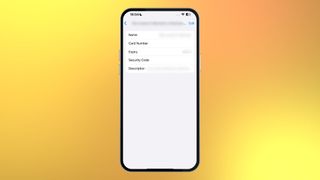
Stephen Warwick has written about Apple for five years at iMore and previously elsewhere. He covers all of iMore's latest breaking news regarding all of Apple's products and services, both hardware and software. Stephen has interviewed industry experts in a range of fields including finance, litigation, security, and more. He also specializes in curating and reviewing audio hardware and has experience beyond journalism in sound engineering, production, and design. Before becoming a writer Stephen studied Ancient History at University and also worked at Apple for more than two years. Stephen is also a host on the iMore show, a weekly podcast recorded live that discusses the latest in breaking Apple news, as well as featuring fun trivia about all things Apple. Follow him on Twitter @stephenwarwick9
Why WWDC 2024 was one of the biggest events in Apple's history
10 last-minute Father's Day Apple gifts that will come in time for the big day
Microsoft's controversial Recall AI feature delayed indefinitely, but you can still test it
Most Popular
- 2 Siri no more? iOS 18 will let you rename your Apple assistant (sort of)
- 3 Apple exec Craig Federighi takes swipe at AI PCs: "I guess we missed the boat"
- 4 Apple to follow TikTok lead on AI-generated content with this clever Image Playground feature
- 5 VSCO updates Terms of Use to include a “non-exclusive worldwide license”, and users aren’t happy
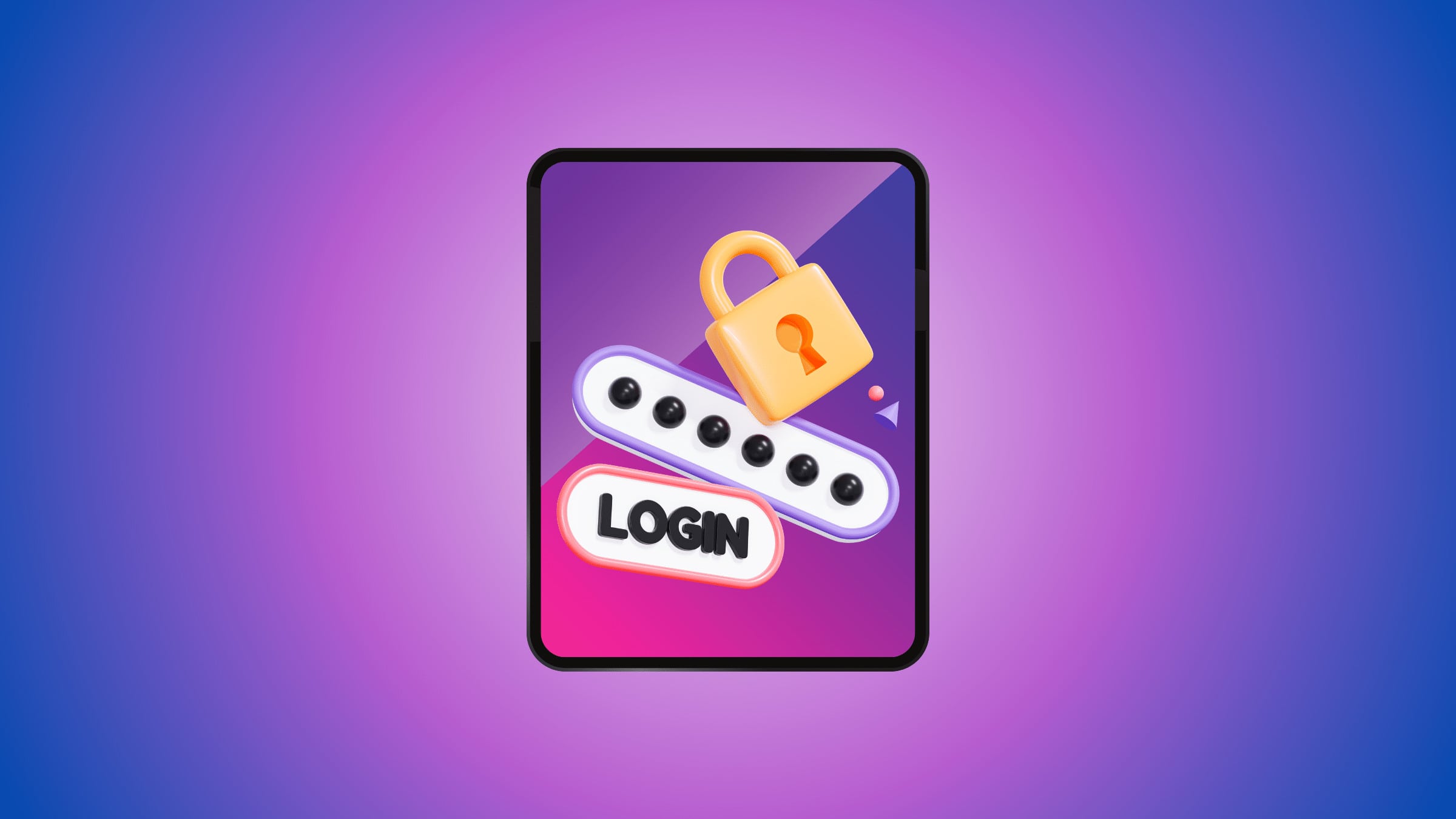
iPad Passwords – Where Are They And How To Access Them
You don’t need to buy or download a password manager for an iPad because your iPad has one already by default, and it’s free.
There is no dedicated app. Apple’s password manager lives within the settings.
Tip: Use strong passwords; don’t re-use passwords.
In this article, I’m going to show you how you can start using the iPad’s built-in password manager, how to find your saved password, and how to find a WiFi password.
How To Find All Passwords Saved on iPad
- Open ‘Settings’
- Scroll down and tap on ‘Passwords’
- You will be asked to authenticate with Face ID or Touch ID, depending on which iPads you have.
Now, you have access to all the saved passwords on your iPad. You can scroll down and find the password you are looking for manually or search for it at the search bar.
You can edit the password simply by tapping on them. You can also tap on the “Edit” button at the top and bulk the password you no longer need.
Tip: You can also ask Siri to open and show you your password. Say “Hey Siri, show me my passwords.”
How To Add Password To iPad
- Tap on the ‘+’ icon at the top
- Tap on ‘New Password’
- Add the title, the website, username, and password. You can even add a note for yourself there.
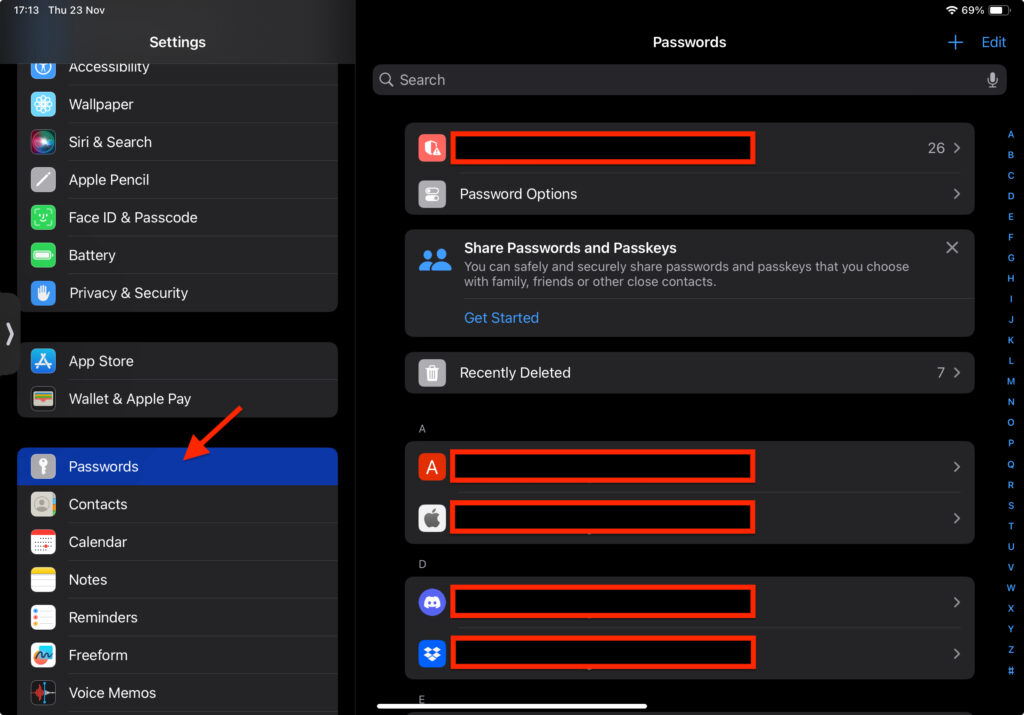
Note: These saved password will only work with apps and with Safari web browser. They won’t work with other browsers like Google Chrome, Mozilla Firefox, Opera, etc.
Security Recommendations
This section will alert you to the risks that are found. It will show you if a website has been compromised and that your password might have been leaked, and Apple will recommend you change it due to high risk.
If you see any recommendations from Apple in this section, do change the passwords on those specific sites and all other websites on which you used that exact password.
iPad Web Browser Passwords
When you save a password from Safari, you will be able to find it in your saved passwords, but when you save passwords from other browsers like Google Chrome, Mozilla Firefox, Brave, Opera, etc. They will be saved and stored on those browsers, not your iPad.
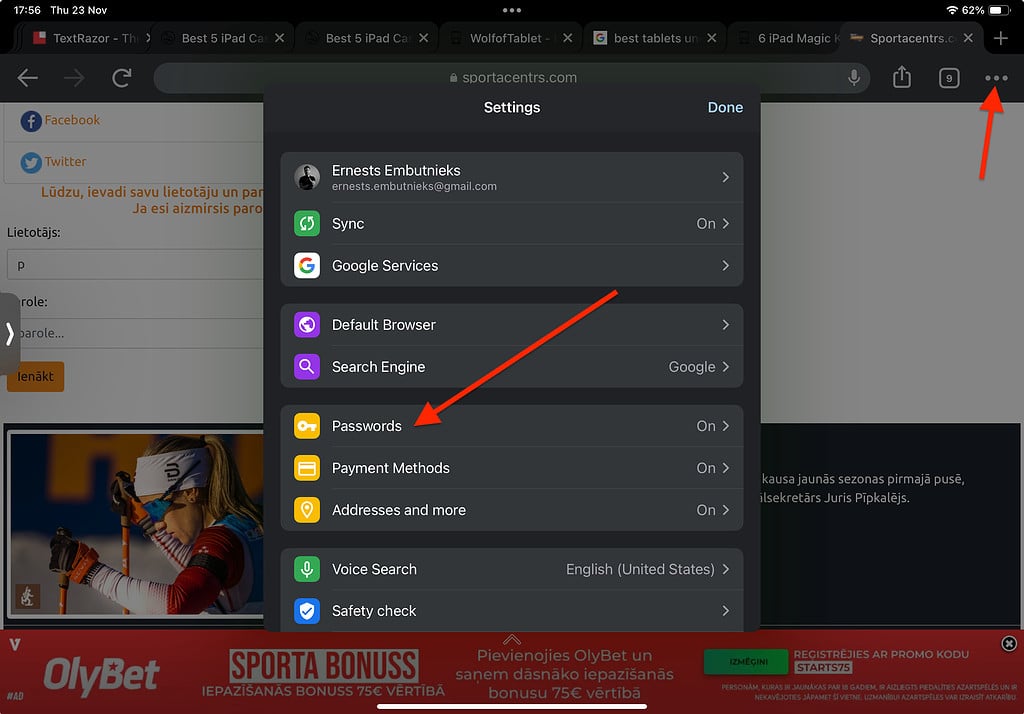
Due to this reason it’s more convenient and more secure to use Safari as the default browser for your iPad.
How To Find WiFi Password on iPad
- Tap on WiFi
- Find the network and tap on the ‘Info’ icon.
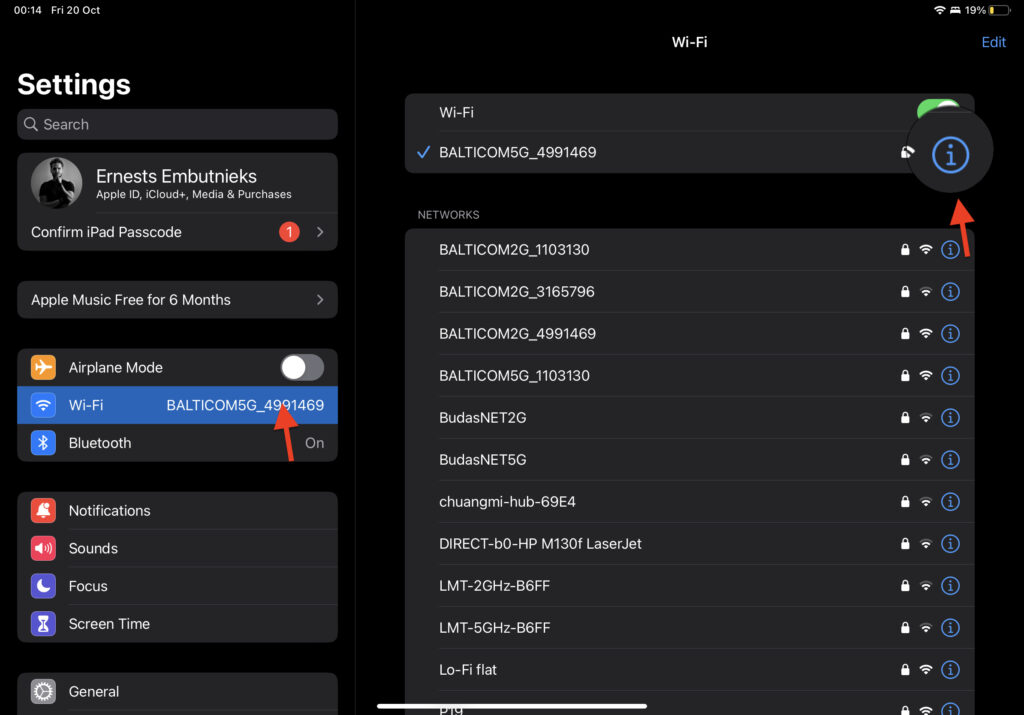
On the next screen, you will see your password, and it will be hidden. Just tap on it. Your iPad will ask you to authenticate with Face ID or Touch ID and after that, it will reveal the password. It will allow you to copy it.
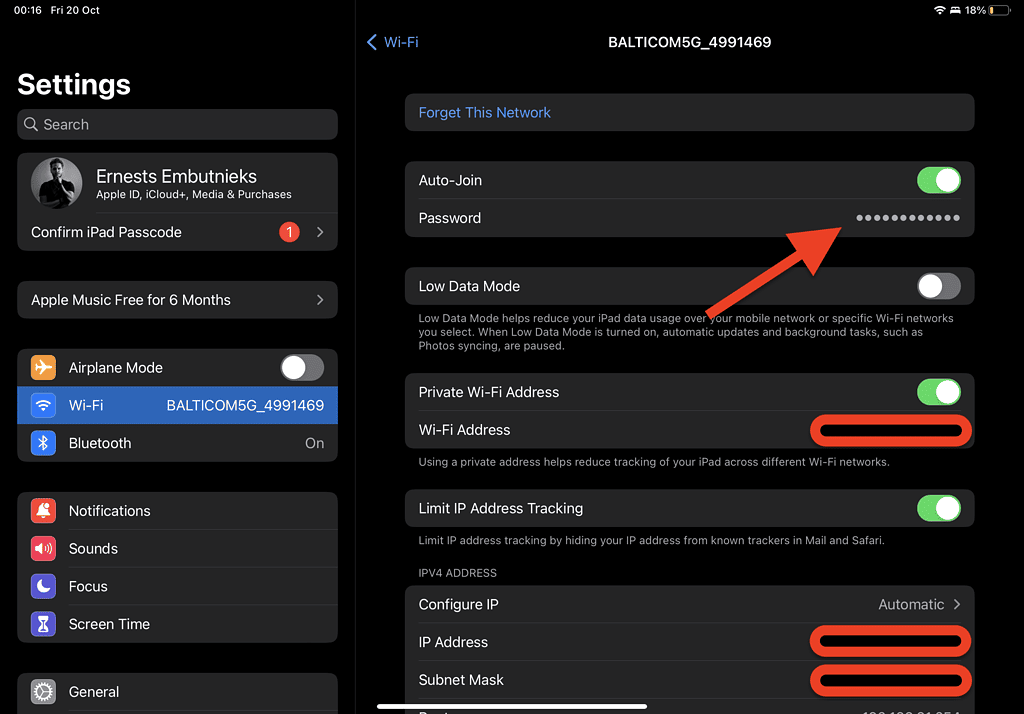
Just FYI: Apple devices have this feature, ‘ Continuity .’ if you copy something on an iPad, you can paste it onto an iPhone, Apple Watch, or MacBook and vice versa.
Related Articles:
iPad Touch ID – How It Works & Which Ones Have It

Ernests Embutnieks
I'm a writer and editor in iPads & Android Tablets, Windows Tablet section. I'm passionate about technology, especially about tablets. I'm on a mission to assist people in discovering their ideal tablets. In addition, I'm dedicated to producing helpful how-to guides and sharing top-notch tips and tricks. In my early carrier I founded and became and editor at worldoftablet and have been a guest author at many other tech blogs. In wolfoftablet I'm focusing on iPads, Tablets, Apple Pencil, Apps, Reviews, Buyers Guides and Tablet Accessories. In free time I like to play games on my PS5 or iOS.
iPad Air 5 Review Samsung Galaxy Tab S9 FE Plus Review Samsung Galaxy Tab S9 Plus Review Samsung Galaxy Tab A8 Review
Laptops vs Tablets Androids Tablets vs iPads Budget Tablets vs Premium
13 Reasons To Buy Tablets Things To Do On Tablets Use Cases For Old Tablets
About Us Contact Us Privacy Policy Terms & Conditions
WolfofTablet.com is a tablet computer media company focusing on tablet computers. Tablet reviews, news, leaks, deals, tablet accessories, comparisons, tips, apps. Mostly focused on tablet ranking. Ranking them by operating system, price, screen size, use case, etc.
Looks like no one’s replied in a while. To start the conversation again, simply ask a new question.
iPad not saving passwords automatically
My IPad Air 2 won’t auto save passwords. I have checked settings, and all is correct to have passwords auto saved. Anyone have any ideas?
iPad Air 3, iPadOS 15
Posted on Oct 12, 2022 3:49 PM
Posted on Oct 13, 2022 3:19 PM
Hey there Dohrmc,
Thanks for reaching out to the Apple Support Communities. Just to confirm, are you using iCloud Keychain to save your passwords on your iPad Air? If so, check out the steps listed in the link below that can help with troubleshooting issues with your passwords not saving as expected: If iCloud Keychain won't turn on or sync - Apple Support
If iCloud Keychain is on, but Safari won't save or AutoFill account or credit card information
If Safari doesn't autofill your account names, passwords, or credit cards, or doesn't ask to save them, make sure you have the latest version of iOS and macOS on your devices. If the issue remains, follow these steps to check the AutoFill and Private Browsing settings on your device.
On your iPhone, iPad, or iPod touch with iOS 10 or later
1. For account names and passwords:
- iOS 14 or later: Go to Settings > Passwords > AutoFill Passwords. Check that AutoFill Passwords is turned on.
- iOS 12 or 13: Go to Settings > Passwords & Accounts > Website & App Passwords. Check that AutoFill Passwords is turned on.
- iOS 10 or 11: Go to Settings > Safari > AutoFill. Check that AutoFill Passwords is turned on.
2. For credit card information, go to Settings > Safari > Autofill. Check that Credit Cards is turned on.
3. Open Safari. If the navigation bar in Safari is black or dark instead of white or light gray, turn off Private Browsing . Safari doesn't save account names and passwords when Private Browsing is on.
Still need help to autofill credit card information? In Safari, tap the credit card field, then tap AutoFill Credit Card above the keyboard.
If still running into issues after going through the steps above, we'd recommend reaching out to Apple Support directly from this link here: Get Support - Apple
Similar questions
- Passwords not auto saving and iPhone is not suggesting strong passwords I updated my iPhone 12 Pro to iOS 15 and now my passwords aren’t auto saving, my saved passwords are gone and I don’t receive strong password suggestions. Is anyone else having similar issues? 4305 1
- Ipad not offering to save passwords My iPad mini 5 does not offer to save new passwords. I have it all turned on in the settings but it never prompts me like my previous iPad did. Anyone else had this problem and solved it? 1396 4
- Saved passwords since my software update last week, my passwords are not visible to me in the saved passwords section. They are there but only show as black dots. Often I refer to the saved passwords in my phone when signing on to a site with my iPad. How can I resume seeing them? 1770 1
Loading page content
Page content loaded
Oct 13, 2022 3:19 PM in response to Dohrmc
- iPhone IMEI Check
- Samsung IMEI Check
- Motorola IMEI Check
- LG IMEI Check
- Xiaomi IMEI Check
- Pixel IMEI Check
- Nokia IMEI Check
- Oppo IMEI Check
- Honor IMEI Check
- iCloud Status Check
- Blacklist Status Check
How to View Saved Passwords in Safari for iPhone and iPad
Safari’s iCloud Keychain makes it pretty easy and convenient for the user to save passwords and other credit card information. It is stored in the iCloud so it is possible to use it on all Apple devices. However, some sites do not support the autofill feature. In this article, you will learn how to view saved passwords in Safari on your iPhone and iPad.
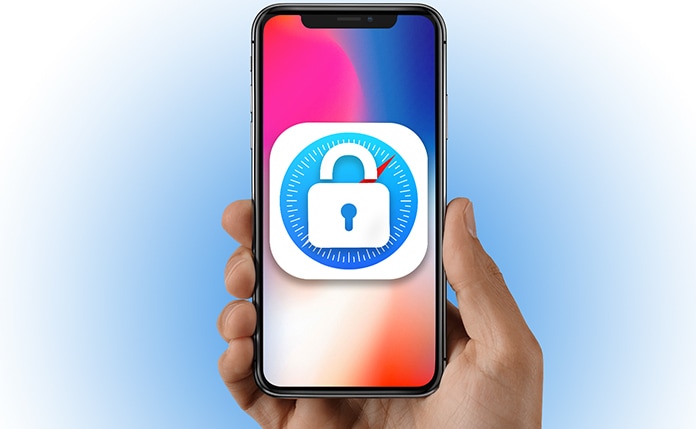
In such a case, you will need to look up the passwords manually and we are here to show you how.
View Saved Passwords in Safari for iOS
In case you have a password saved in Safari’s iCloud Keychain , you will probably be able to use autofill, but if not just follow the steps below:
Step 1: Launch the Settings app.
Step 2: Scroll down and tap on Safari.
Step 3: Go to General and tap on Passwords.

Step 4: Use Touch ID or enter your four digit code.
Step 5: Scroll down and tap on the website name that you are looking for the password to.
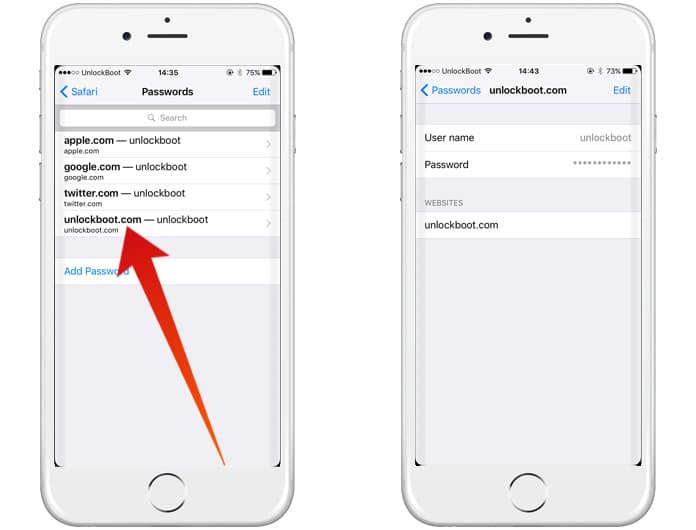
Step 6: Press and hold on the password tab to copy it.
After it has been copied, you can go paste the password wherever required.

Setting up Autofill Information in Safari
In case you have not already, you can set up Safari’s autofill feature by adding your personal information.
- Go to the Settings page.
- Scroll down till you reach Safari and tap on it.
- Under the General section select Autofill.
- Tap on My Info.
- Choose your name from the contacts list.
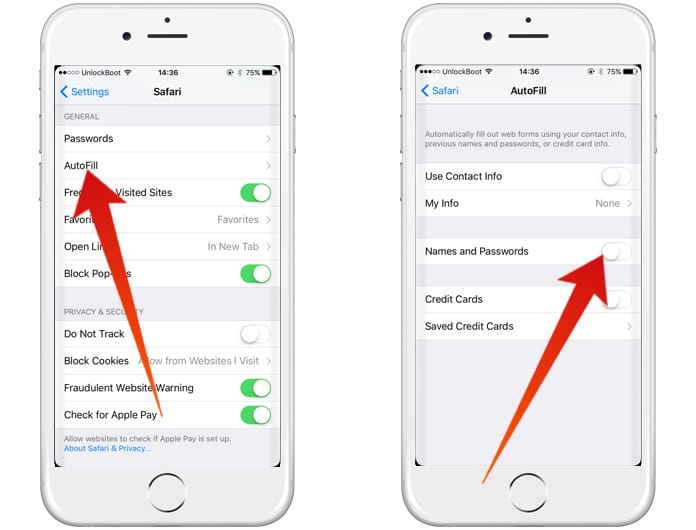
You can now manage or disable the Autofill in Safari.
View & Manage Saved Credit Cards in Safari
In case you want your credit card number and expiration date, you can check it out without logging into a website.
- Again go to Settings.
- Scroll down and tap on Safari .
- Tap on Saved Credit Cards.
- Then use your Touch ID to sign in or alternatively enter your four digit code.
- Select the credit card number you want to see.
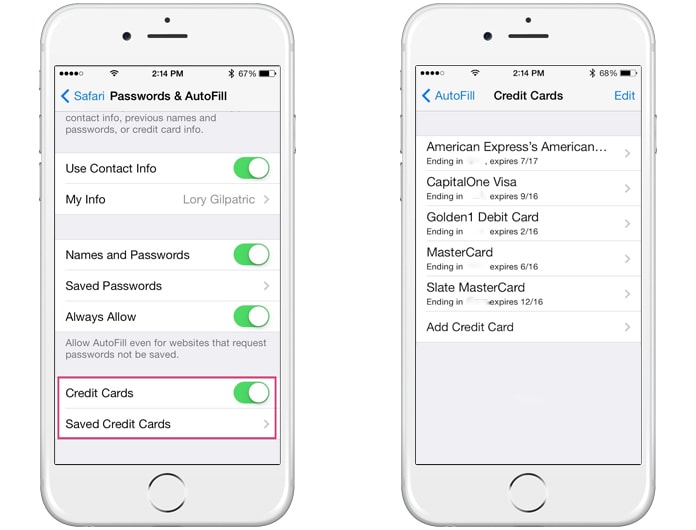
That is all there is to it. If you have any questions or queries please let us know in the comments section below.
RELATED ARTICLES MORE FROM AUTHOR
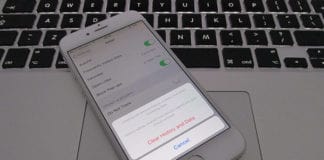
Simple Way To Clear Safari History On iPhone and iPad

How to Turn On or Off Private Browsing On iPhone or iPad

Download Safari for Windows 10, 8 or 7 and Use it on PC
Related articles to read, top this week on unlockboot.

Best Free IPA Download Sites To Install iOS Apps for iPhone

Install GBA Emulator iPhone With iOS 11 / 12 Without Jailbreak

Official iCloud Removal Service to Bypass iCloud Activation

Bypass iOS 7.1.2 Activation Lock & Jailbreak iPhone 4

Bypass iCloud Activation Lock iOS 8.1.3 / 11 / iOS 12.2

iPhone is Disabled Error Fix Without iTunes Restore

How to Check if Samsung Phone is Unlocked or Locked

10 Best Mac Torrent Sites in 2021 to Fulfill your Streaming...
- Privacy Policy
- Cookies Policy
- Accessories
- Meet the team
- Advertise with us

Whenever I wish to visit some of my favorite websites, I don’t want to enter login details for them. And I guess most of you don’t like it either. So, what’s the better way to get over it securely? Pretty simple! If you are using iOS, you can enable Safari to save passwords for websites you frequently visit on your iPhone. Not for nothing, Safari is considered to be the most secure web browser. You can take full advantage of it to browse the web securely. I will talk more about what stands it apart. For now, let’s get to know how its AutoFill password feature works!
How to Enable Safari to Save Passwords for Websites
Step #1. Open Settings app on your iOS device.
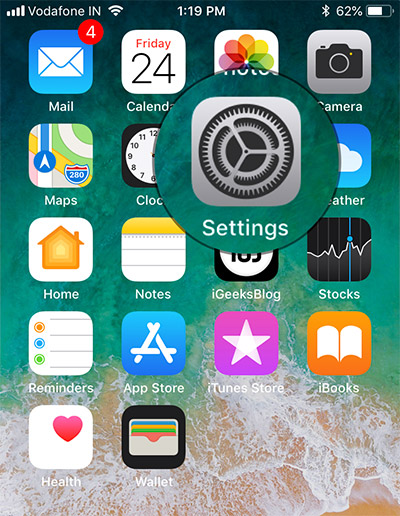
Step #2. Now, scroll down and tap on Passwords & Accounts.
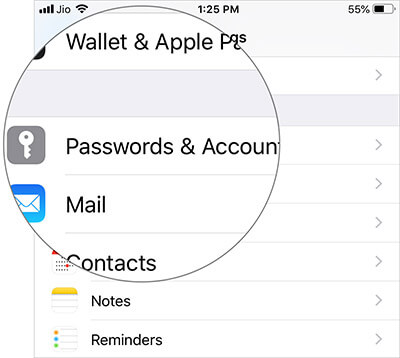
Step #3. Ensure that the switch next to AutoFill Passwords is turned ON , if it’s not already.
Note: in iOS 11, you need to go to Settings → Safari → AutoFill → Turn on the switch next to Names and Passwords.
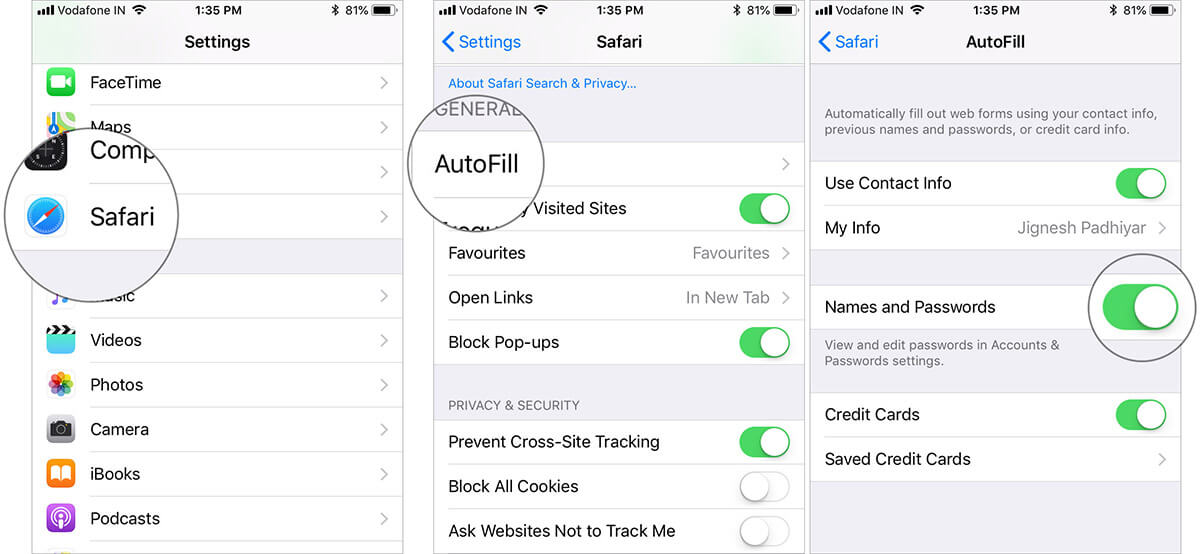
From now onwards, when you visit any site and log in, Safari will ask you to save the passwords. If you often visit that site, save the password and you are done!
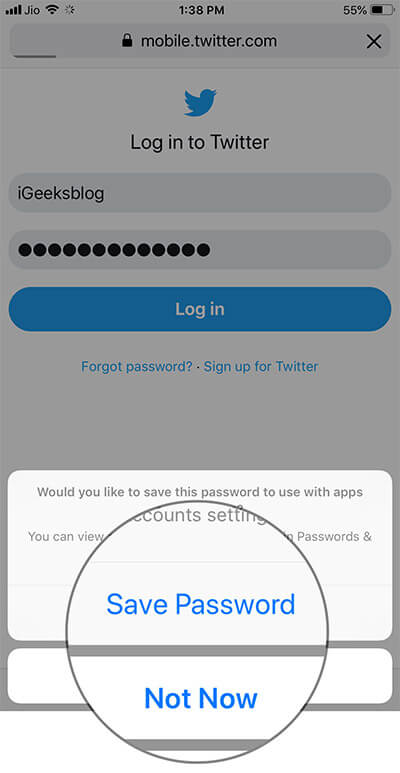
If you ever want to stop the web browsing from asking you to save the passwords, follow the same steps mentioned above and then turn off the switch next to AutoFill Passwords.
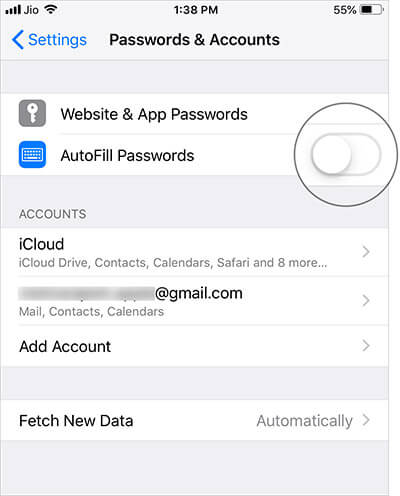
How to Manage Saved Passwords on iPhone and iPad
iOS 12 lets you manage all of your saved app and website passwords with ease. For instance, you can delete them and even change passwords right from the settings app.
Step #1. Launch the Settings app on your iOS device → Passwords & Accounts.
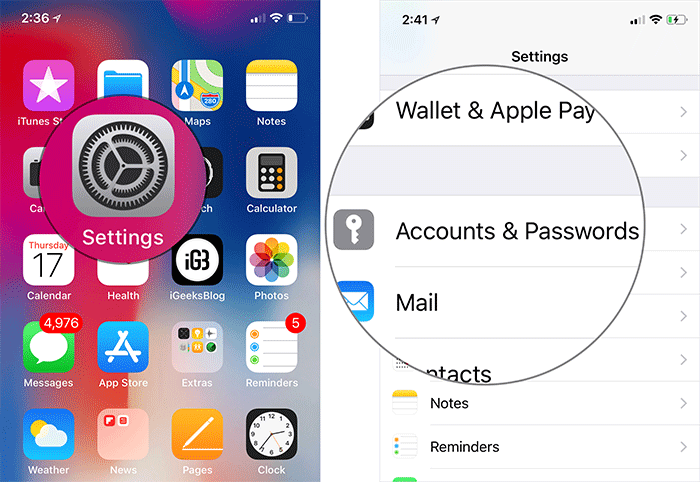
Step #2. Now, tap on Website & App Passwords.
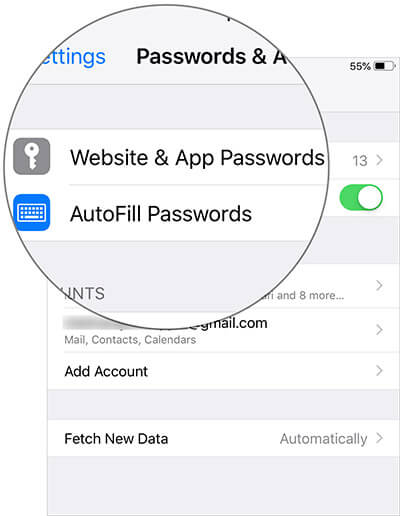
Delete the Saved Website and Its Associated Passwords
Tap on the Edit button at the top right and then select the website/s you want to delete. Then, hit Delete and confirm.
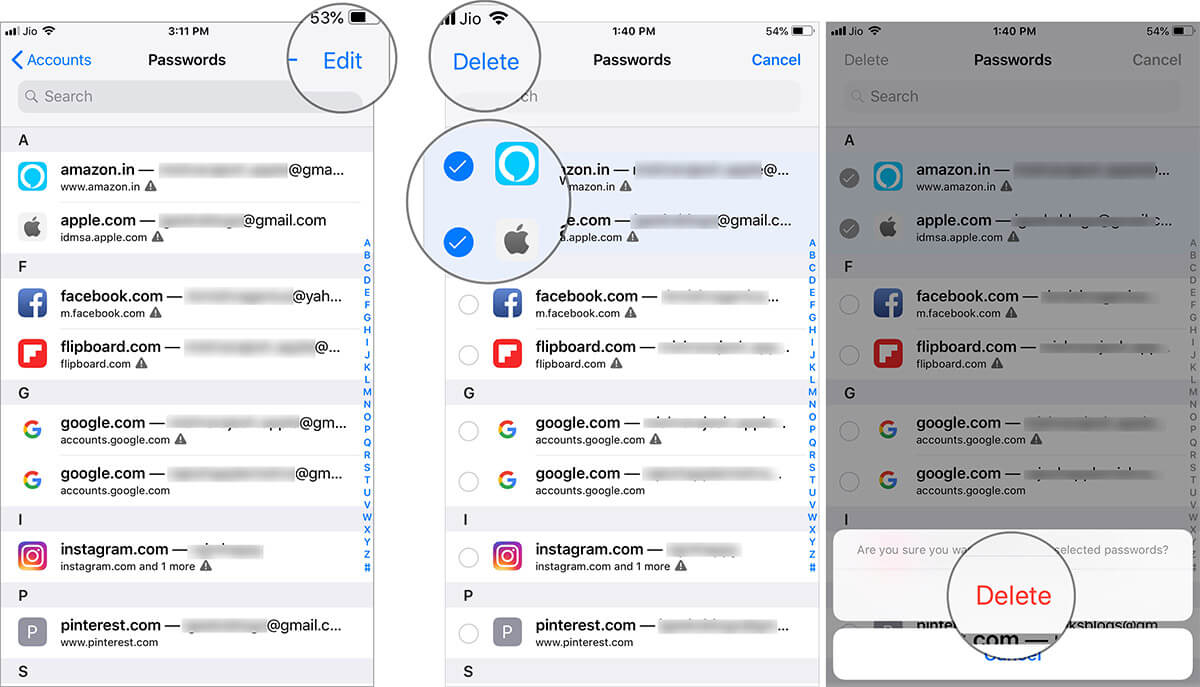
Change Passwords
Tap on the respective website. Then, tap on Change Password on Website. Next, you can enter a wrong password and then tap on “Forgotten password.” Next up, follow the usual steps to change it.
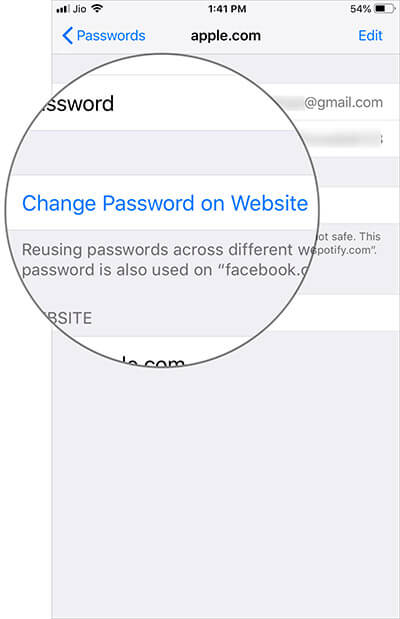
That’s pretty much it!
Over to you
With the built-in password manager, it’s become pretty simple take control of passwords. Moreover, all of your secret keys are saved to iCloud Keychain and synchronized across your synced devices. So, you can comfortably use them across your trusted devices.
Besides, Safari also suggests you strong passwords to ensure your account has the needed safeguard. And if it finds that you are using the same passwords with multiple websites, it warns you to change them.
You might want to refer these posts as well:
- How to Share Passwords using AirDrop
- How to customize suggested strong passwords in Safari on iPhone
- How to change Keychain password on Mac: 3 Ways explained
- AutoFill Passwords not working on iPhone and iPad
The founder of iGeeksBlog, Dhvanesh, is an Apple aficionado, who cannot stand even a slight innuendo about Apple products. He dons the cap of editor-in-chief to make sure that articles match the quality standard before they are published.
🗣️ Our site is supported by our readers like you. When you purchase through our links, we earn a small commission. Read Disclaimer .
LEAVE A REPLY Cancel reply
Save my name, email, and website in this browser for the next time I comment.
Related Articles
How to delete duplicate photos on iphone and tips for avoiding them, how to use live voicemail on iphone in ios 17 and ios 18, how to use eye tracking in ios 18 and ipados 18, why does my iphone randomly vibrate and how to fix it.
- WWDC 2024 /
Apple’s standalone Passwords app syncs across iOS, iPad, Mac, and Windows
Apple’s new passwords app takes icloud keychain to the next level..
By Umar Shakir , a news writer fond of the electric vehicle lifestyle and things that plug in via USB-C. He spent over 15 years in IT support before joining The Verge.
Share this story
:format(webp)/cdn.vox-cdn.com/uploads/chorus_asset/file/25485523/lcimg_11ca1204_67f3_40b3_81b4_e9423b01662a.jpeg)
At WWDC 2024 , Apple revealed a new Passwords app that expands on its existing iCloud Keychain features and syncs your passwords across more devices. Now, with Passwords , Apple is releasing a standalone app to manage passwords and passkeys on more devices, including Apple’s Vision Pro headset, as well as Macs, iPhones, and iPads. It also syncs with PCs via the iCloud for Windows app.
- Apple made an iPad calculator app after 14 years
- Apple WWDC 2024: the 13 biggest announcements
Platforms that have so far gone unmentioned? Just as the earlier rumor indicated , Google Chrome and Android. You can also view your Wi-Fi passwords in one place and share passwords in groups with people you want to have them.
One big advantage could be that it will integrate even more deeply with your Apple logins and family sharing setups than other options like 1Password or Bitwarden. And with the backing of Apple, it may seem like a safer option for people spooked by security breaches suffered by others like LastPass .
For years, Apple users would have to get their saved passwords from the Safari preferences window and later from Mac System Preferences or iOS Settings. Now, with the Passwords app, everything is in one place, including verification codes and security alerts.
Apple is shutting down Apple Pay Later just months after launch
Apple’s fancy new carplay will only work wirelessly, us sues adobe for ‘deceiving’ subscriptions that are too hard to cancel, nintendo direct june 2024: all the news and trailers, zelda is finally getting her own game.
More from this stream WWDC 2024: Apple Intelligence, iOS 18, macOS 15, and more
The new versions of ios and macos will let you rotate your wi-fi address to help reduce tracking., can apple intelligence fix the iphone’s broken notifications system, siri warns you that chatgpt might be lying., ios 18 will let you record calls — and tells everyone for their privacy.
You are using an outdated browser. Please upgrade your browser to improve your experience.
iOS 18 Passwords app can't import passwords, but macOS can

Only the macOS Sequoia Passwords app can import passwords, for now
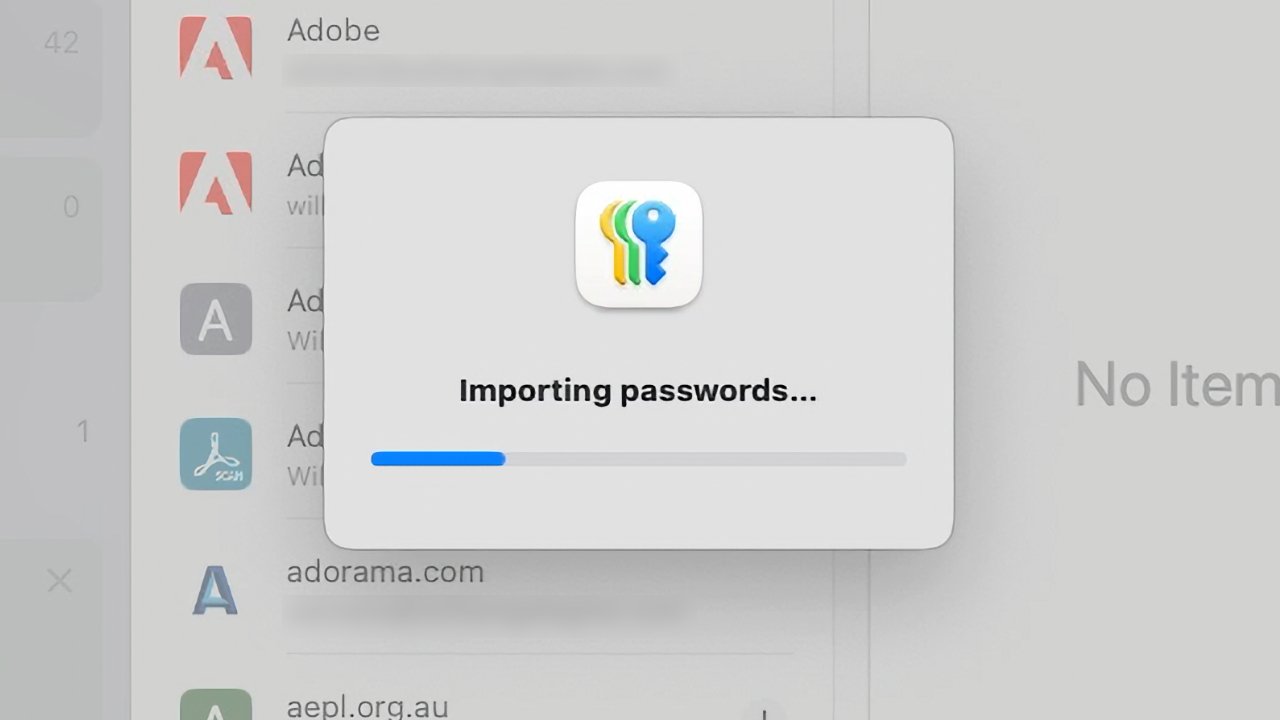
Apple made a point of saying that it has spent 25 years working on securing passwords for users, but still users of its new Passwords app may be surprised at the result. For Passwords does not open without any passwords, it instead has everything ever saved via Safari — which can be hundreds of login passwords.
It also contains Wi-Fi login passwords, which can go back years to old and long-forgotten routers. The new Passwords app also automatically includes any Passkeys.
So right from the first launch of the app, Passwords users may have a large collection of existing passwords. What they won't have, of course, is any that are exclusively saved in third-party password managers such as 1Password or LastPass.
With the iOS 18 version of Passwords, at this stage of the beta process, users aren't going to get those other passwords either. On iOS 18, passwords can only be entered one at a time, by Safari adding them, or by the user typing in the details manually.
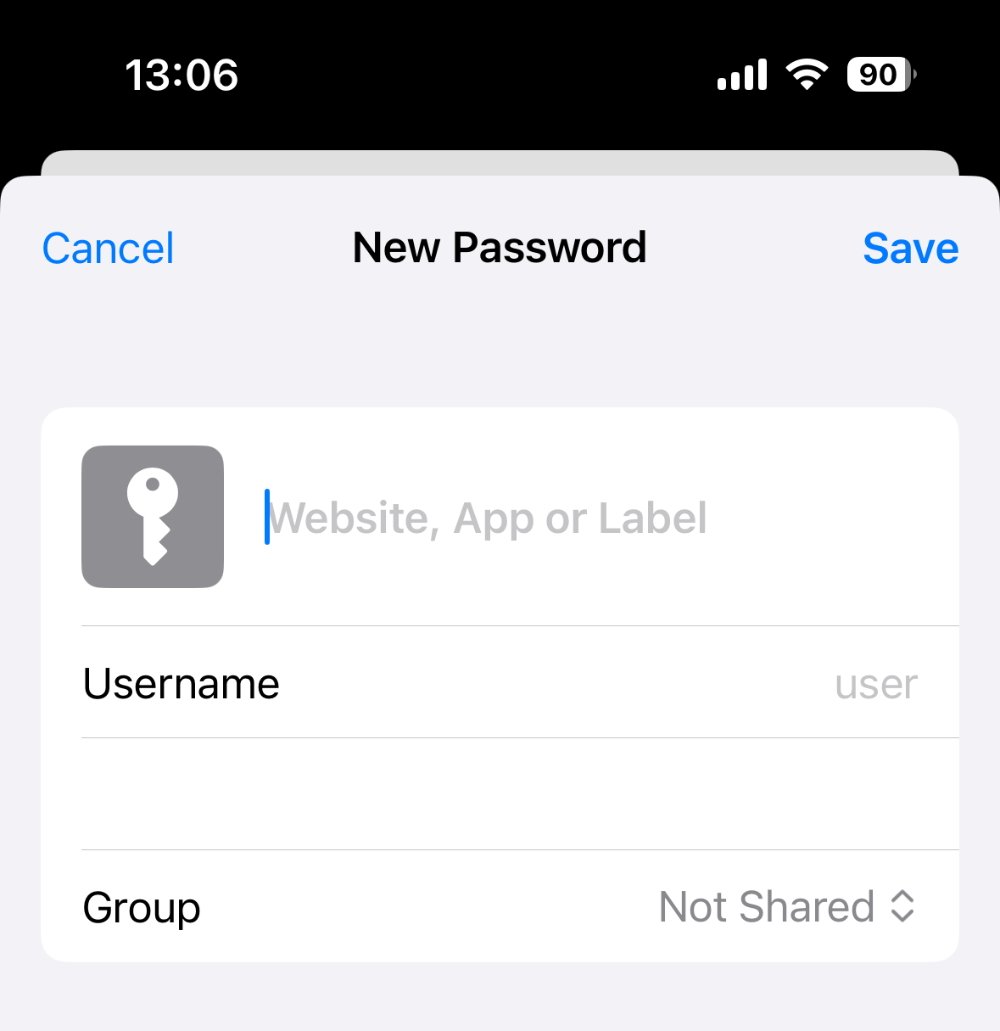
Nicely, though, when you manually start entering a new password on either iOS 18 or macOS Sequoia, it offers a suggested strong one. In iOS 18, that strong password is pre-entered for you, while on the Mac it's offered through a drop-down menu.
However, a more significant difference in macOS Sequoia and iOS 18's otherwise identical Passwords apps concerns importing. The Mac version does include an import option while the iOS 18 one does not as yet.
Then Mac one will only import passwords saved in a .csv file, so a third-party app has to be able to export in this format. It's not a great idea to have a .csv copy of all your passwords as that's a plain-text and easily readable format, so the exported file must be deleted quickly.
Passwords on macOS Sequoia is quite slow at importing passwords. In a first test, it took over five minutes to import a .csv file with around 3,500 passwords in it — and then more than two minutes more before they appeared in the app.
The Passwords app was also unable to import everything. Existing passwords won't be overwritten, but beyond that Passwords just reports the word "conflict" next to ones it couldn't import.
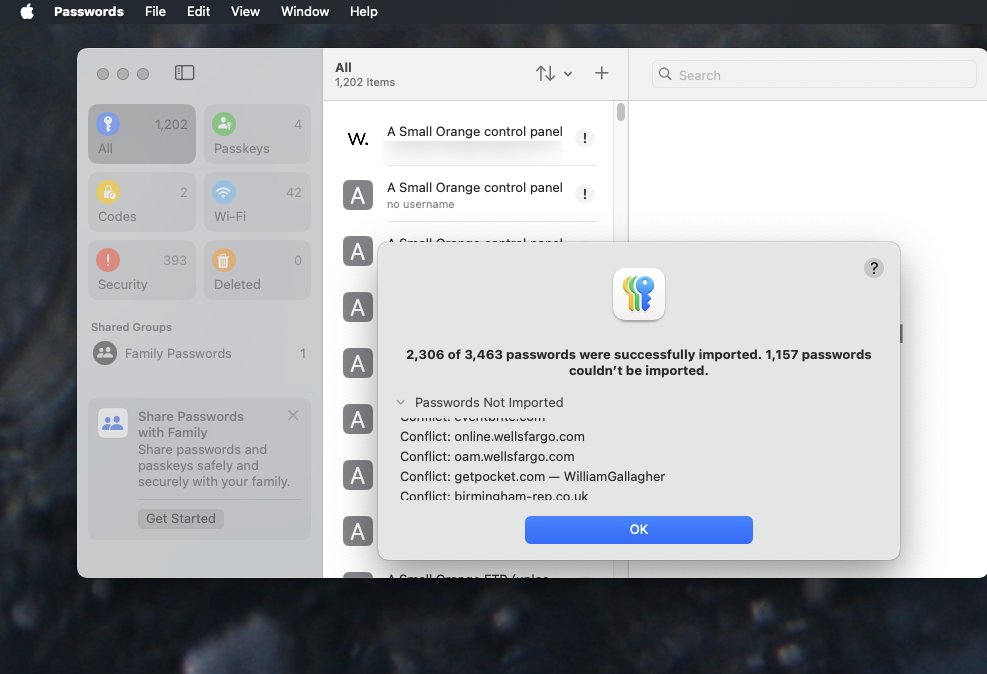
That "conflict" word and the passwords it failed on are only shown in the import dialog box. There's no apparent way to save that list or return to check through it later.
Presumably because the third-party rival's export feature does not include this data, there's also no way to see when an imported password was last updated. Imported ones are all shown as having been modified today.
Note that this test was done on the first developer betas of iOS 18 and macOS Sequoia.
This one is another one of Apple's "first version" applications. Useful if you're already fully invested in the Apple ecosystem, but not very compelling if you've already invested in another solution, or need a cross-platform solution. And while it doesn't apply to me, the prospect of sorting through hundreds, perhaps thousands, of old passwords to weed out the ones no longer relevant is...daunting.
I will not use Apple's password manager for several reasons: - Passwords will be stored and synced in cloud - You can import (on macOS) but probably not export - Limited features To me it looks like the main reason for Apple to make a password manager is to make it harder for customers to switch to another platform.
xyzzy-xxx said: I will not use Apple's password manager for several reasons: - Passwords will be stored and synced in cloud - You can import (on macOS) but probably not export - Limited features To me it looks like the main reason for Apple to make a password manager is to make it harder for customers to switch to another platform. Possibly, but your passwords are not stored on iCloud in a form that Apple can read. All user data passed to iCloud is end-to-end encrypted, and Apple has stated (and proven) there is very little data they can give to law enforcement wrt iCloud stored data. So no, your passwords are NOT stored in iCloud in any form that is useful to Apple or law enforcement (if that’s what you’re worried about). Further, you can absolutely export passwords on Mac. I have to do this for people who are moving from one platform to another all the time. Maybe you should try actually reading up on the subject you’re pontificating on?
xyzzy-xxx said: I will not use Apple's password manager for several reasons: - Passwords will be stored and synced in cloud - You can import (on macOS) but probably not export - Limited features To me it looks like the main reason for Apple to make a password manager is to make it harder for customers to switch to another platform. I'm not sure about the latest version, but in all prior versions you could turn off iCloud syncing of passwords. Also, it's very easy to export all of your Mac passwords. This has been supported for a long time. I'm not sure how that limits moving to another platform. Most of these features have been available on the Mac for quite a while. Apple just put them into a more visible app which is easier to use. I don't see any downsides to it.
chasm said: xyzzy-xxx said: I will not use Apple's password manager for several reasons: - Passwords will be stored and synced in cloud - You can import (on macOS) but probably not export - Limited features To me it looks like the main reason for Apple to make a password manager is to make it harder for customers to switch to another platform.
Absolutely you can export passwords if you want/need to go back to Windows. Not only that, I thought Apple also said the new Password app would be folded into the iCloud tools for Windows no less should you want/need to use a Windows machine concurrently with other Apple products, so that will be handy for those unable to completely ditch Windows.
Top Stories

B&H's MacBook Pro Mega Deal Zone knocks up to $550 off

M4 Macs, iPhone 16, and more: What Apple has planned for the rest of 2024

M4 MacBook Pro upgrade could arrive by end of 2024

Apple Vision Pro sequel stalls as work on cheaper consumer headset continues

EU has very serious issues with Apple, says competition chief

How Apple will label AI-generated images made with Image Playground
Featured deals.

Apple's M3 Pro MacBook Pro plunges to $1,699
Latest exclusives.

What happened to Safari Web Eraser — the controversy, and what it looked like

Siri is reborn in iOS 18 — everything Apple's voice assistant will be able to do

iOS 18 Mail app will get huge AI enhancements & summarizations with 'Project Blackpearl'
Latest comparisons.

AirPods Max vs. Sonos Ace: premium personal audio, compared

More Metal: Apple's iPad Pro Magic Keyboards, compared

Top AI tablets: iPad Pro with M4 versus Microsoft's new Surface Pro
Latest news.

Apple's new 'Help Me Choose' quiz helps users find the right Mac
Apple's website was recently updated to include an all-new Help Me Choose quiz, created to help potential customers find the Mac best suited for their needs and within their budget.

Apple could be planning to update the MacBook Pro lineup to M4 chips before the end of 2024, based on OLED screen production timetables.

Logitech's new stylus for Oculus is what we want for Apple Vision Pro
Apple has arguably the best VR headset in the world with the Apple Vision Pro, but it's fallen behind Logitech on the one accessory it should have invented.

Apple's follow-up to the Apple Vision Pro may not be a high-end model, with work allegedly halted on the premium replacement in favor of a cheaper alternative.

JP Morgan raises Apple stock target to $245 on AI announcements
Analysts at JP Morgan say that Apple's launch of AI features will prompt users to upgrade their iPhones, and has raised the price target by $20.

Staggering $300 discount hits Apple's M2 MacBook Air with 16GB RAM, 512GB SSD
The steep $300 discount drops the upgraded M2 15-inch MacBook Air with 16GB RAM and a 512GB SSD to $1,399.

Beats Solo Buds review: Apple's best wireless audio bargain yet
The Beats Solo Buds are the cheapest wireless earphones Apple produces, yet still offer outstanding battery life and an astoundingly small case.

Apple Developer Academy gets new Artificial Intelligence curriculum
Apple Developer Academy is gaining a new core curriculum to teach students about taking advantage of artificial intelligence, available across 18 academies in 6 countries.

EU to settle Apple Pay NFC probe after Apple's concessions
The European Union has reportedly accepted a series of concessions that Apple has made over allowing third-party rivals access to its hardware NFC systems at the core of Apple Pay.
Latest Videos

Retro gold rush: which emulators are on the App Store, and what's coming

Best features in watchOS 11 for Apple Watch

Our favorite features so far in iOS 18 from Control Center to Genmoji
Latest reviews.

Dockcase Studio Smart USB-C Hub 8-in-1 Review - Powerful hub with perplexing features.

PNY Elite-X Type-C Drive review: Small size, huge convenience

{{ title }}
{{ summary }}
- Social media
- Artificial Intelligence
- Cybersecurity
- Small business
- Software and Apps
- Kim's column
- All shopping
- Kim's Picks
- Find a station

- Kim’s column
- Kim’s Picks
- Get Komando Community – 30 days free!
How to find all the passwords hidden and saved on your Mac
By Kim Komando
Have you ever forgotten an old password or an outdated username? We all have. We also know having unique passwords for every online account is a pain, but it’s critical! Tap or click here to find out how cybercriminals can use reused passwords .
With so many passwords to remember, some people save them on their devices. Fortunately, there’s a way to find all the passwords your Apple computer has stored locally.
The next time you’re in a pickle, you can use this tip to see every password saved to your Mac through Safari.
How to find all your passwords on a Mac
The process for finding passwords on your Mac is relatively simple. NOTE : You can view saved passwords in System Preferences in macOS Monterey or later.
Here’s how:
- Choose Apple menu > System Preferences .
- Click Passwords .
- Sign in with Touch ID or enter your user account password. You can also authenticate your password with your Apple Watch running watchOS 6 or later.
- Select a website and then click Edit .
- Not only can you see passwords, but you can change or delete them.
- To delete a password, click Delete Password . To update a password, change the password and then click Save .
RELATED : Apple security tip: Use private browsing to erase your digital tracks (iPhone, iPad, Mac)
You don’t have to go through System Preferences to find saved passwords. You can also do it through Safari.
Finding saved passwords in Safari
You can also see your saved passwords using Safari.
- Open Safari .
- From the Safari menu, choose Preferences , then click Passwords .
- Sign in with Touch ID or enter your user account password. You can also authenticate your password with your Apple Watch running watchOS 6 or later.
This is also an easy way to change your passwords regularly, which is one of our top tips for keeping your accounts safe. Of course, we find it to be indispensable when we’ve forgotten a password or username.
You may also like : Never lose your Apple gadgets again when you enable this simple setting
Boostlink Steamboat
Apple’s standalone Passwords app syncs across iOS, iPad, Mac, and Windows
/cdn.vox-cdn.com/uploads/chorus_asset/file/25485523/lcimg_11ca1204_67f3_40b3_81b4_e9423b01662a.jpeg?w=1200&resize=1200,0&ssl=1)
At WWDC 2024 , Apple revealed a new Passwords app that expands on its existing iCloud Keychain features and syncs your passwords across more devices. Now, with Passwords , Apple is releasing a standalone app to manage passwords and passkeys on more devices, including Apple’s Vision Pro headset, as well as Macs, iPhones, and iPads. It also syncs with PCs via the iCloud for Windows app.
You can also view your Wi-Fi passwords in one place and share passwords in groups with people you want to have them.
One big advantage could be that it will integrate even more deeply with your Apple logins and family sharing setups than other options like 1Password or Bitwarden. And with the backing of Apple, it may seem like a safer option for people spooked by security breaches suffered by others like LastPass .
For years, Apple users would have to get their saved passwords from the Safari preferences window and later from Mac System Preferences or iOS Settings. Now, with the Passwords app, everything is in one place, including verification codes and security alerts.
Source link
Related Posts

OpenAI is devouring the media industry
Time’s almost up! There’s only one week left to request an invite to The AI Impact Tour on June 5th.…

Aeternum Brings the MMO to Consoles with Cross-Play; New 10-Player Raid Coming
At Summer Game Fest 2024, Amazon Games announced New World: Aeternum, which brings the MMO originally launched on PC in…
/cdn.vox-cdn.com/uploads/chorus_asset/file/25472813/stompersapp.jpg?w=1200&resize=1200,0&ssl=1)
This walking app let me whack my co-workers with a baseball bat
Violence is never the answer. That said, it was fun when I opened a walking app and whacked a Verge…
Leave a Reply Cancel reply
Your email address will not be published. Required fields are marked *
Save my name, email, and website in this browser for the next time I comment.

LastPass: Free Password Manager
Description.
Saving Passwords In Your Browser? You Shouldn't: Here's Why

Your changes have been saved
Email Is sent
Please verify your email address.
You’ve reached your account maximum for followed topics.
Why Scammers Love Using WhatsApp and Telegram to Slide Into Your DMs
Crypto scammers are using this legendary broadcaster's name to trick you on x, gpt-4 vs. gpt-4 turbo vs. gpt-4o: what's the difference.
Everyone should already know how important it is to use strong passwords. Ideally, you'd have a different password for each account, and all of them would be long, complex, and contain numbers and special characters.
Few abide by these rules, which is understandable. After all, who could remember all these passwords? It seems much more convenient to just store them somewhere, like in a browser for example. But that's not a very good idea.
Why Storing Your Passwords in a Browser Is a Terrible Idea
Most browsers nowadays display a "save password" pop-up whenever the user signs up to a website. So, if you click "save" when that pop-up appears, the browser stores your credentials, and you don't have to type them in the next time you log in to that same website.
This functionality is called Autofill, and enables browsers to automatically populate forms and login fields with information ranging from passwords and usernames, to billing details and even credit card numbers . Definitely practical, but also a bit of a cybersecurity nightmare—a lot can go wrong if you allow a browser to store your credentials.
To take an obvious example, what if you share your device with others? Storing your passwords and usernames on a work computer's browser is asking for trouble. Even if you're confident your co-workers or family members would never violate your privacy, there's no need to take that much risk for a little bit of convenience.
Then there's also the fact that most browsers lack built-in two-factor and multi-factor authentication capabilities. This means that all an intruder would have to do is gain access to your device somehow. They wouldn't be asked to jump through any additional hoops, i.e. put in a one-time verification code, scan their face, or leave a fingerprint.
Extensions and add-ons are great if you want to customize your browser, but malicious ones sometimes slip through the cracks and can pose a significant risk to security. Imagine what would happen with your accounts if a malicious extension allowed an attacker to obtain your saved passwords?
Add to this a myriad of other cybersecurity threats, like malware and phishing, and it becomes glaringly obvious why storing your passwords in a browser is not recommended.
How to Remove Saved Passwords From a Browser
If you already have a bunch of passwords stored in your browser, there's no need to panic. You can remove them all quickly and easily, with just a few clicks.
If you're using Chrome (or other Chromium-based browsers, like Brave), click the three little dots or bars in the upper right corner, and then navigate to Settings in the drop-down menu. On the left, there should be a list of tabs, one of which should say Auto-fill or Autofill and passwords . Open that tab, and remove the passwords.
You can do the same in Firefox by navigating to Settings > Privacy & Security > Saved Logins . To delete all passwords stored in Firefox, click the three dots in the upper right corner (right below the address bar), and then click Remove All Logins . Confirm the action, and you're done.
If you have a Mac computer and are using Safari, you need to launch the Apple menu (top left corner), and then navigate to System Settings > System Preferences . Choose Passwords , and enter your Mac user password. After that, select the passwords you want to remove, or simply click Remove All .
The process is almost identical on smartphones. Whether you've got an iPhone or an Android phone, you should be able to remove passwords and other credentials in less than a couple of minutes by following these instructions.
Where Can I Store My Passwords Instead?
Most of us have a few dozen accounts all over the web, and log into them daily. Were you to follow elementary security rules, you'd have a different password for each account, and change it periodically. This would inevitably result in password fatigue , which is a phenomenon that occurs when one has to remember too many login credentials.
The bottom line is this: you should not store passwords in your browser, but you should also use unique passwords for each account you own. On the other hand, you can't realistically remember so many complex phrases, most of which include digits and whatnot. What is the solution, then? Using a password manager.
Password managers are specialized applications that store and manage user credentials. With password managers, all you need to do is remember one phrase, called the master password. And sometimes not even that, because some software uses biometric data (i.e. your fingerprint or face).
There are plenty of password managers on the market , but arguably the best are Bitwarden, NordPass, and Dashlane. All three have free and premium versions, so even if budget is a concern, you should be able to work something out. More importantly, they use strong encryption algorithms, and will keep your credentials safe. Safer than a browser would, in any case.
It should also be noted that Bitwarden and NordPass are available on virtually all platforms, while Dashlane is focused on the mobile market, with apps for Android and iOS. Dashlane does have a Chrome extension and a Firefox add-on, however, which might also be a good option for some (though having dedicated software installed on your device is comparably safer).
Businesses and large organizations in particular would benefit from investing in an enterprise password manager , instead of relying on employees' memory and cybersecurity awareness. In this category, Keeper is probably the best solution, with its zero-trust architecture and AES 256-bit encryption.
You're Only as Safe as Your Password
Some claim biometrics will replace passwords altogether at some point in the near future. Until that happens, passwords will remain an exceptionally efficient access control mechanism, which means they will also remain a prime target for hackers and intruders.
Storing your passwords safely and securely is an absolute must, which is why you should consider getting a password manager. And until you do, familiarize yourself with the most common tricks cybercriminals use to hack passwords.
- Password Tips

How to Clip Photos in Safari on Your iPhone or iPad
W hile we're still coming off the iOS 18 excitement announced at WWDC 2024 yesterday , too often there are small, overlooked features from previous versions that don't get enough attention. iOS 16 in particular introduced so many solid features that still make us happy when we get to rediscover them, even if you don't use them much.
The clipping feature in Photos lets you grab the subject from an image and share it in any app or turn it into a sticker for later use, and it's easy and super fun to play around with. But hidden in Safari is a similar feature that'll let you quickly copy the subject from almost any image and share it wherever you want. We'll show you how to do it below.
For more tech tips and news, don't miss how to download the iOS 18 developer beta and everything to know about Apple Intelligence, its take on AI .
How to clip images in Safari on iOS or iPad OS
In the Safari web browser on your iPhone or iPad, find any image and press your finger down on it for about a second. The image should isolate under your finger, and a quick action menu will appear, with various options. Now, the one you want to use is Copy Subject , which will copy the subject of the photo to your clipboard.
Unfortunately, you can't control which subject is selected, so choose a photo with a clearly differentiated subject and background. (In the photo above, I chose to use this feature with a skateboarder in the forefront.)
After you press Copy Subject, you can go into a message and paste in the clipped subject to share it with someone else. You can also drop it into a saved note to keep the clipped subject for yourself.
The clipping won't always be perfect, so as mentioned previously, choose an image with a large and obvious subject, and preferably an image with a uniform background.
For more, don't miss how Apple's best new iPhone and iPad features are long overdue and why isn't Apple Intelligence in the Vision Pro ?


IMAGES
VIDEO
COMMENTS
Bear in mind, of course, Apple's password autofill is a security risk, especially if you don't have a startup password or PIN code on your iPad. With password autofill, anyone who got hold of your iPad could get into websites and impersonate you -- including ordering goods or making financial transactions.
Here's how to manually add usernames and passwords to Safari's AutoFill. Open the "Settings" app on your iOS device. Scroll down a bit and pick "Passwords.". Tap on the plus sign at the top. Fill in the information of the site you want to save. Double-check for any mistakes and tap "Done.".
Use the search field or scroll down to the one you need and tap it to place it in the password text field. If you want to create another password, tap Add New Password near the top of the Autofill Password list. Enter your username and a password. Tap Done to save the information to Keychain. To view saved passwords, open the Settings app and ...
Here's how. First, launch "Settings," which can usually be found on the first page of your Home screen or on your Dock. Scroll down the list of Settings options until you see "Passwords & Accounts." Tap it. In the "Passwords & Accounts" section, tap "Website & App Passwords." After you pass authentication (using Touch ID, Face ID, or your ...
You can securely keep notes about recovery key information, security questions, PIN numbers, and similar details. Go to Settings > Passwords, then tap an account. Tap Add Notes, enter your text, then tap Done. To view the notes later, go to Settings > Passwords, then tap the account. To update the notes, tap Edit (at the top right), then tap ...
View saved passwords and passkeys in Settings. Tap Settings, then scroll down and tap Passwords. Use Face ID or Touch ID when prompted, or enter your passcode. To view a password or passkey, select a website or app. To delete a saved password or passkey, tap Delete Password or Delete Passkey. To update a password or passkey, tap Edit.
Access the passwords manager by first opening the "Settings" on your iOS device. Scroll to and tap open "Safari" in the left column, then tap open the "Passwords" category. Before you can access your passwords, you will need to verify your identity using Touch ID. On older devices that don't have Touch ID, you will need to enter your passcode.
Open the Settings app. Swipe down and tap on Passwords. Tap Edit in the top right corner to delete multiple logins or swipe from right to left to delete individual items. Tap on an item to see the ...
In iOS 17, iPadOS 17, and macOS Sonoma 14, or later, one-time verification codes are filled in automatically, so you don't need to leave the app or website you're signing into.You can choose to automatically delete the verification codes after entering them with Autofill, or keep them. Do one of the following: On your iPhone or iPad: Go to Settings > Password, select Password Options, then ...
Safari password list on Mac. To sort the list by website, username, or password, just click the column header. Editing passwords on Mac. To see details for the site, username, and password, select one and click Details or simply double-click it.. Here you can make edits to your saved username or password; however, this will not change those credentials on the actual website.
On Mac, the Safari password manager is located by choosing Safari on the menu bar at the top left of your Mac. From there, click Settings from the pull-down menu. Next, click on the Passwords ...
To access and manage saved passwords in Safari, users can navigate to the Settings app on their iPad and locate the "Safari" option. Within the Safari settings, selecting the "Passwords" section provides users with a comprehensive overview of their saved login credentials. Upon entering this section, users may be prompted to authenticate their ...
Click the three horizontal dots within a circle at the bottom of the list of passwords. Highlight and select Export All Passwords…. Click the Export Passwords… button to confirm. Name the .csv file. Change the location for where you want to export Safari passwords. Click the Save button.
Here's how to find it: Open the Settings app. Scroll down and tap Safari. Under the General section tap AutoFill. (Image credit: Future / Apple) Tap Saved Credit Cards. Use Face ID or Touch ID to verify your identity (or your four-digit code) Select the credit card you want to view.
Launch Safari on your iPhone or iPad and browse to a website for which you already have an account. Enter your username and password, and a prompt should pop up asking if you want to save this ...
iPad Web Browser Passwords. When you save a password from Safari, you will be able to find it in your saved passwords, but when you save passwords from other browsers like Google Chrome, Mozilla Firefox, Brave, Opera, etc. They will be saved and stored on those browsers, not your iPad.
3. Open Safari. If the navigation bar in Safari is black or dark instead of white or light gray, turn off Private Browsing. Safari doesn't save account names and passwords when Private Browsing is on. Still need help to autofill credit card information? In Safari, tap the credit card field, then tap AutoFill Credit Card above the keyboard.
View saved passwords in Safari on iPhone/iPad. Step 1: On your iPhone/iPad, go to Settings > Passwords. Step 2: When prompted, use your face ID, Touch ID, or passcode to open the page. Step 3: The page lists all websites/services for which passwords are saved.
In this tutorial, you will learn how to save passwords in Safari browser on Mac, iPhone and iPad.Method 1: On MacClick on the "Safari" menu, then select "Pre...
In this tutorial, you will learn how to see saved passwords in Safari browser on Mac, iPhone and iPad.Method 1: On MacClick on the "Safari" menu, then select...
View Saved Passwords in Safari for iOS. In case you have a password saved in Safari's iCloud Keychain, you will probably be able to use autofill, but if not just follow the steps below: Step 1: Launch the Settings app. Step 2: Scroll down and tap on Safari. Step 3: Go to General and tap on Passwords. Step 4: Use Touch ID or enter your four ...
How to Enable Safari to Save Passwords for Websites. Step #1. Open Settings app on your iOS device. Step #2. Now, scroll down and tap on Passwords & Accounts. Step #3. Ensure that the switch next to AutoFill Passwords is turned ON, if it's not already. Note: in iOS 11, you need to go to Settings → Safari → AutoFill → Turn on the switch ...
Apple's new Passwords app takes iCloud Keychain to the next level. By Umar Shakir , a news writer fond of the electric vehicle lifestyle and things that plug in via USB-C. He spent over 15 years ...
Apple's new Passwords app comes with every password ever saved in Safari, but only macOS Sequoia's version can import new ones from a third-party app. Apple made a point of saying that it has ...
To update a password, change the password and then click Save. RELATED: Apple security tip: Use private browsing to erase your digital tracks (iPhone, iPad, Mac) You don't have to go through ...
At WWDC 2024, Apple revealed a new Passwords app that expands on its existing iCloud Keychain features and syncs your passwords across more devices.Now, with Passwords, Apple is releasing a standalone app to manage passwords and passkeys on more devices, including Apple's Vision Pro headset, as well as Macs, iPhones, and iPads.It also syncs with PCs via the iCloud for Windows app.
Save all your passwords, addresses, credit cards and more in your secure vault and LastPass will automatically fill in your information when you need it. Stop wasting time getting locked out of accounts or filling passwords and forms online - LastPass simplifies your daily online tasks while keeping you and your family secure.
If you have a Mac computer and are using Safari, you need to launch the Apple menu (top left corner), and then navigate to System Settings > System Preferences. Choose Passwords, and enter your Mac user password. After that, select the passwords you want to remove, or simply click Remove All. The process is almost identical on smartphones.
Apple revealed a new password manager at WWDC 2024, aiming to take over other leading players like LastPass as the go-to password manager for iPhone, iPad, and Mac.. During the annual WWDC keynote ...
For more tech tips and news, don't miss how to download the iOS 18 developer beta and everything to know about Apple Intelligence, its take on AI.. How to clip images in Safari on iOS or iPad OS ...